Dear visitor,
The Armenian Genocide Museum-Institute will be closed from December 31 till January 2, 2024.
Sincerely,
The Armenian Genocide Museum-Institute Foundation
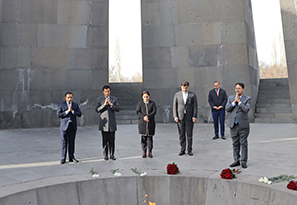
Nepal's Foreign Minister Narayan Prakash Saud visited the Armenian Genocide Memorial
15.12.2023
The delegation led by Nepal's Foreign Minister Narayan Prakash Saud visited the Armenian Genocide Memorial on December 15.
Edita Gzoyan, acting director of the Armenian Genocide Museum-Institute, welcomed the guests, then accompanied them to the Genocide Memorial complex, presenting the history of its creation.
The guests from Nepal laid flowers at the Eternal Fire and observed a minute’s silence in memory of the innocent martyrs of the Armenian Genocide.
They also toured the Armenian Genocide Museum, and became acquainted with the permanent and temporary exhibitions at the Armenian Genocide Museum, after which Mr. Narayan Prakash Saud left a note in the Memory Book for Honoured Guests.
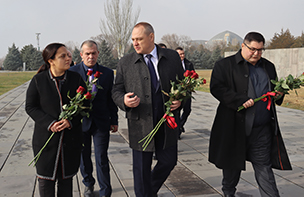
The delegation of the Ministry of Internal Affairs of Belarus visited the Armenian Genocide Memorial
14.12.2023
The delegation of the Ministry of Internal Affairs of Belarus led by Police Major General Maxim Mironov visited the Armenian Genocide Memorial on December 14.
Edita Gzoyan, acting director of the Armenian Genocide Museum-Institute, welcomed the guests, then accompanied them to the Genocide Memorial complex, presenting the history of its creation. She also narrated the history of the three khachkars placed in Tsitsernakaberd in memory of the Armenians who died in the massacres organised by the government of Azerbaijan in the cities of Sumgait, Kirovabad (Gandzak), and Baku at the end of the 20th century, as well as the stories of the five freedom fighters buried in front of the Memory Wall who died during the Artsakh struggle for survival. She emphasised the connection between the Armenian Genocide and contemporary acts of persecution and violence against Armenians and also referred to the historical and legal aspects of the Artsakh issue, describing Azerbaijan's anti-Armenian actions and propaganda.

Botswana Foreign Minister Lemogang Kwape visited the Armenian Genocide Memorial
13.12.2023
Botswana's Foreign Minister Lemogang Kwape visited the Armenian Genocide Memorial on December 13 accompanied by RA Deputy Foreign Minister Vahe Gevorgyan.
Edita Gzoyan, acting director of the Armenian Genocide Museum-Institute, welcomed the guests, then accompanied them to the Genocide Memorial complex, presenting the history of its creation. She also narrated the history of the three khachkars placed in Tsitsernakaberd in memory of the Armenians who died in the massacres organised by the government of Azerbaijan in the cities of Sumgait, Kirovabad (Gandzak), and Baku at the end of the 20th century, as well as the stories of the five freedom fighters buried in front of the Memory Wall who died during the Artsakh struggle for survival. She emphasised the connection between the Armenian Genocide and contemporary acts of persecution and violence against Armenians and also referred to the historical and legal aspects of the Artsakh issue, describing Azerbaijan's anti-Armenian actions and propaganda.
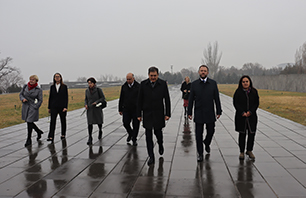
Estonian Foreign Minister Margus Tsahkna visited the Armenian Genocide Memorial
13.12.2023
Estonian Foreign Minister Margus Tsahkna, who arrived in Armenia on a working visit, visited the Armenian Genocide Memorial, accompanied by RA Deputy Foreign Minister Paruyr Hovhannisyan.
Edita Gzoyan, acting director of the Armenian Genocide Museum-Institute, welcomed the guests, then accompanied them to the Genocide Memorial complex, presenting the history of its creation. She also narrated the history of the three khachkars placed in Tsitsernakaberd in memory of the Armenians who died in the massacres organised by the government of Azerbaijan in the cities of Sumgait, Kirovabad (Gandzak), and Baku at the end of the 20th century, as well as the stories of the five freedom fighters buried in front of the Memory Wall who died during the Artsakh struggle for survival. She emphasised the connection between the Armenian Genocide and contemporary acts of persecution and violence against Armenians and also referred to the historical and legal aspects of the Artsakh issue, describing Azerbaijan's anti-Armenian actions and propaganda.

The head of the French delegation to the PACE, Bertrand Bouyx, visited the Armenian Genocide Memorial
12.12.2023
The head of the French delegation to the Parliamentary Assembly of the Council of Europe (PACE), Bertrand Bouyx, visited the Armenian Genocide Memorial on December 12, accompanied by the Ambassador Extraordinary and Plenipotentiary of France to Armenia, Olivier Decottignies.
Edita Gzoyan, acting director of the Armenian Genocide Museum-Institute, welcomed the guests, then accompanied them to the Genocide Memorial complex, presenting the history of its creation. She also narrated the history of the three khachkars placed in Tsitsernakaberd in memory of the Armenians who died in the massacres organised by the government of Azerbaijan in the cities of Sumgait, Kirovabad (Gandzak), and Baku at the end of the 20th century, as well as the stories of the five freedom fighters buried in front of the Memory Wall who died during the Artsakh struggle for survival. She emphasised the connection between the Armenian Genocide and contemporary acts of persecution and violence against Armenians and also referred to the historical and legal aspects of the Artsakh issue, describing Azerbaijan's anti-Armenian actions and propaganda.
Mr. Bertrand Bouyx laid a wreath at the memorial to the victims of the Armenian Genocide, after which the guests laid flowers at the Eternal Fire and observed a minute’s silence in memory of the innocent martyrs of the Armenian Genocide.

The newly appointed Ambassador of Colombia to Armenia Hector Isidro Arenas Neira visited the Armenian Genocide Museum
08.12.2023
The newly appointed Ambassador of Colombia to Armenia Hector Isidro Arenas Neira (residence: Moscow) visited the Armenian Genocide Museum on December 6.
Lusine Abrahamyan, AGMI Deputy Director for Museum Affairs, welcomed the ambassador at the museum and presented the exhibition.
At the end of the visit, the newly appointed ambassador of Colombia, Hector Isidro Arenas Neira, also made a note in the Memory Book for honorable guests.
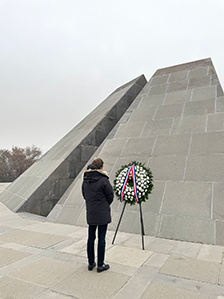
Geoffroy Didier, member of the European Parliament, visited the Armenian Genocide Memorial complex
08.12.2023
Geoffroy Didier, French member of the European Parliament, visited the Armenian Genocide Memorial complex on December 6.
The delegation was greeted by Lusine Abrahamyan, AGMI Deputy Director for Museum Affairs, who narrated the history of the creation of the Memorial complex. She also presented the guests with the history of the three khachkars placed in the Tsitsernakaberd area in memory of the Armenians who died in the massacres in the cities of Sumgait, Kirovabad (Gandzak) and Baku in the last century organised by the Azerbaijani government, and the stories of the five freedom fighters buried in front of Memory Wall during the Artsakh war, emphasising the connection between what happened then and the Armenian Genocide.
Mr. Geoffroy Didier laid a wreath at the memorial to the victims of the Armenian Genocide, after which the accompanying guests laid flowers at the Eternal Fire and observed a minute’s silence in memory of the innocent martyrs of the Armenian Genocide.
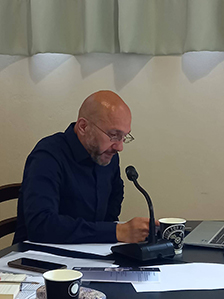
Robert Tatoyan, Armenian Genocide Museum-Institute Senior Researcher, participated in the international scientific conference held in Athens
02.12.2023
The international conference titled “Armenians and Jews: The Traumatic Ruptures of Genocides” was held in Athens, Greece on November 2-3. Robert Tatoyan, AGMI senior researcher, was a participant and delivered a presentation.
The AGMI researcher’s study titled “The activities of the Constantinople Armenian Patriarchate in 1919-1921, aimed at statistical counting of human and material losses suffered by the Ottoman Armenians as a result of the Armenian Genocide” was received with great interest by conference participants.
The conference was organised by the University of Athens, École Française d'Athènes and the Institute of International Relations.
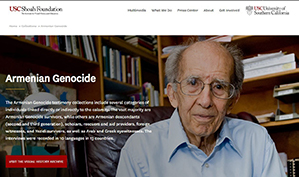
The rich collection of the Visual History Archive of the Shoah Foundation, University of Southern California, is available to Armenian scholars from now on
01.12.2023
The "Armenian Genocide Museum-Institute" Foundation (AGMI), having been recognised as a collection partner within the famework of the co-operation agreement reached between it and the University of Southern California, on behalf of its USC Shoah Foundation - The Institute for Visual History and Education (USC SF), in October 2022, may freely access its USC SF Visual History Archive from now on.
AGMI employees may, from now on, use the rich archive of the Shoah Foundation, where thousands of video recordings of the survivors of the Armenian Genocide and other genocides and mass murders are collected, without restriction. This archive also includes the collection of oral histories of the Armenian Genocide (more than 1,000 video recordings of Armenian Genocide survivors) created by Richard Hovhannisyan and which will, at his suggestion and agreement, be made available to the AGMI after their complete restoration and digitization.

US Deputy Secretary of State for Educational and Cultural Affairs, 2016-2019 Charge d'Affaires of the US in Armenia Rafik Mansour visited the Armenian Genocide Memorial
30.11.2023
Rafik Mansour, US Deputy Secretary of State for Educational and Cultural Affairs, 2016-2019 Chargé d'Affaires of the US in Armenia, visited the Armenian Genocide Memorial on November 30, accompanied by the employees of the US Embassy in Armenia.
Edita Gzoyan, acting director of the Armenian Genocide Museum-Institute, welcomed the guests, then accompanied them to the Genocide Memorial complex, presenting the history of its creation. She also narrated the history of the three khachkars placed in Tsitsernakaberd in memory of the Armenians who died in the massacres organised by the government of Azerbaijan in the cities of Sumgait, Kirovabad (Gandzak), and Baku at the end of the 20th century, as well as the stories of the five freedom fighters buried in front of the Memory Wall who died during the Artsakh struggle for survival. She emphasised the connection between the Armenian Genocide and contemporary acts of persecution and violence against Armenians and also referred to the historical and legal aspects of the Artsakh issue, describing Azerbaijan's anti-Armenian actions and propaganda.

Members of the Lithuania-Armenia friendship group visited the Armenian Genocide Memoria complex
29.11.2023
Raimundas Lopata, head of the Lithuania-Armenia friendship group, led the delegation that visited the Armenian Genocide Memorial complex on November 29, accompanied by Arsen Torosyan, the head of the Armenia-Lithuania friendship group of the RA NA, and Andrius Pulokas, extraordinary and plenipotentiary ambassador of Lithuania to the Republic of Armenia.
Edita Gzoyan, acting director of the Armenian Genocide Museum-Institute, welcomed the guests, then accompanied them to the Genocide Memorial complex, presenting the history of its creation. She also narrated the history of the three khachkars placed in Tsitsernakaberd in memory of the Armenians who died in the massacres organised by the government of Azerbaijan in the cities of Sumgait, Kirovabad (Gandzak), and Baku at the end of the 20th century, as well as the stories of the five freedom fighters buried in front of the Memory Wall who died during the Artsakh struggle for survival. She emphasised the connection between the Armenian Genocide and contemporary acts of persecution and violence against Armenians and also referred to the historical and legal aspects of the Artsakh issue, describing Azerbaijan's anti-Armenian actions and propaganda.

AGMI PROJECT HAS BEEN APPROVED
25.11.2023
The application, submitted by the Armenian Genocide Museum-Institute Foundation's Armenian Genocide Victims’ Documentation and Data Collection Department within the framework of the RA ESSC Committee of Higher Education and Science’s competition for the modernisation of the equipment base of the scientific divisions, has been approved. It is planned to purchase 27 devices within this financing framework. The project, aimed at re-equipping the museum-institute with modern technical means, will allow:
a. The re-invigoration of the sub-discipline of oral history.
b. The continuous collection and research of the oral histories of the 2nd, 3rd and 4th generations of the descendants of the victims and survivors of the Armenian Genocide, in order to enrich the planned appropriate database.

Recollections of Exile:
Haykanush Makinajian-Aharonian from Erzerum
23.11.2023
Haykanush Makinajian-Aharonian’s memoir (Erzerum, 1898 – Baghdad, 1963), held in the AGMI museum collections, is a valuable source for the study of various episodes of the Armenian Genocide. The memoir, titled "Recollections of Exile: Erzerum – Mosul," although not large (86 pages), provides valuable insights for the study of the deportations, massacres, abductions of women and children and the violence inflicted upon Armenians from Erzerum and its surrounding areas.
The author, Haykanush Khachaturi Makinajian-Aharonian was born in Erzerum, western Armenia. She was one of six children and was 17 years old when the Armenian Genocide began. She lost all the members of her family, one after the other, during several months of their deportation.

Fabian Salvioli, United Nations special rapporteur on truth, justice and reparation, visited the Armenian Genocide memorial complex
22.11.2023
Fabian Salvioli, UN Special Rapporteur on the promotion of truth, justice, reparation and guarantees of non-recurrence, visited the Armenian Genocide memorial complex on November 22, 2023.
Edita Gzoyan, acting director of the Armenian Genocide Museum-Institute, welcomed the guests, then accompanied them to the Genocide Memorial complex, presenting the history of its creation. She also narrated the history of the three khachkars placed in Tsitsernakaberd in memory of the Armenians who died in the massacres organised by the government of Azerbaijan in the cities of Sumgait, Kirovabad (Gandzak), and Baku at the end of the 20th century, as well as the stories of the five freedom fighters buried in front of the Memory Wall who died during the Artsakh struggle for survival. She emphasised the connection between the Armenian Genocide and contemporary acts of persecution and violence against Armenians and also referred to the historical and legal aspects of the Artsakh issue, describing Azerbaijan's anti-Armenian actions and propaganda.

“The Armenian Genocide is the first modern genocide”.
Abdullatif Jamal Rashid, President of Iraq, visited the Armenian Genocide memorial complex
22.11.2023
Abdullatif Jamal Rashid, President of the Republic of Iraq, who arrived in Armenia on an official visit, headed a delegation visiting the Armenian Genocide memorial complex, accompanied by Vahan Kerobyan, Minister of Economy of the Republic of Armenia, on November 22, 2023.
Edita Gzoyan, Acting Director of the Armenian Genocide Museum-Institute, welcomed the guests. She accompanied them to the Genocide Memorial complex, presenting the history of its creation.
President Rashid placed a wreath at the memorial to the victims of the Armenian Genocide, after which the guests accompanying him laid flowers at the Eternal Fire and observed a minute’s silence in memory of the innocent martyrs of the Armenian Genocide. President Rashid then planted a silver fir at the Memory Park.

Niels Annen, Parliamentary State Secretary to the Federal Minister for Economic Cooperation and Development of the Federal Republic of Germany, visited the Armenian Genocide memorial complex
21.11.2023
Niels Annen, Parliamentary State Secretary to the Federal Minister for Economic Cooperation and Development of Germany, led a delegation visiting the Armenian Genocide Memorial complex on November 21, 2023.
Edita Gzoyan, acting director of the Armenian Genocide Museum-Institute, welcomed the guests. She then accompanied them to the Genocide memorial complex, presenting the history of its creation. She also narrated the history of the three khachkars placed in Tsitsernakaberd in memory of the Armenians who died in the massacres organized by the government of Azerbaijan in the cities of Sumgait, Kirovabad (Gandzak), and Baku at the end of the 20th century, as well as the stories of the five freedom fighters buried in front of the Memory Wall who died during the Artsakh struggle for survival. She emphasised the connection between the Armenian Genocide and contemporary acts of persecution and violence against Armenians and also referred to the historical and legal aspects of the Artsakh issue, describing Azerbaijan's anti-Armenian actions and propaganda.
Mr Niels Annen placed a wreath at the memorial to the victims of the Armenian Genocide, after which the guests accompanying him laid flowers at the Eternal Fire and observed a minute’s silence in memory of the innocent martyrs of the Armenian Genocide. Mrs Gzoyan accompanied the guests to the Memory Wall, which contains, in special niches on its reverse side, small containers of soil taken from the graves of several 19th and 20th-century foreign public figures, politicians, intellectuals and missionaries who raised voices of protest against the massacres and deportations of Armenians carried out by the Turkish government. The guests were very interested, particularly in Johannes Lepsius’ and Armin T. Wegner's pro-Armenian activities.

Gaël Perdriau, Mayor of Saint-Étienne, visited the Armenian Genocide Memorial Complex
20.11.2023
Gaël Perdriau, Mayor of Saint-Étienne, led a delegation visiting the Armenian Genocide Memorial complex, accompanied by the Deputy Mayor of Kapan, Gor Tadevosyan, on November 20. The delegation included François Rochebloin, former French National Assembly deputy, who was the rapporteur of the Armenian Genocide recognition law adopted by France in January 2001 and the author of the resolution criminalising the denial of the Armenian Genocide in France; Vrezh Khosrovyan, president of the Saint-Étienne Armenian Association; Jean Kotchian, advisor to the Mayor of Saint-Étienne and descendant of a Armenian Genocide survivor and others.
Edita Gzoyan, acting director of the Armenian Genocide Museum-Institute, welcomed the guests. She then accompanied them to the Genocide Memorial complex, presenting the history of its creation. She then narrated the history of the three khachkars placed in Tsitsernakaberd in memory of the Armenians who died in the massacres organized by the government of Azerbaijan in the cities of Sumgait, Kirovabad (Gandzak), and Baku at the end of the 20th century, as well as the stories of the five freedom fighters buried in front of the Memory Wall who died during the Artsakh struggle for survival. She emphasised the connection between the Armenian Genocide and contemporary acts of persecution and violence against Armenians and also referred to the historical and legal aspects of the Artsakh issue, describing Azerbaijan's anti-Armenian actions and propaganda.

FAIZ EL-GHUSEIN
On the occasion of his 140th birth anniversary
18.11.2023
The testimonies of Faiz El-Ghusein (1883–1968), a lawyer and the son of one of the leaders of the El-Sulût bedouin tribe in the Hauran region of Syria, plays a significant role among the Arabic-language primary sources on the Armenian Genocide. Not only do they carry great weight, presenting the facts, but also study the reasons why the Young Turk government carried out the Armenian Genocide, as well as the forms and methods of killing Armenians, while shedding light on other important circumstances.
Faiz El-Ghusein served as governor (kaymakam) of the Kyakhta (Gerger) district of the Malatya sanjak of Kharberd province (the vilayet of Harput or Mamuret-ul-Aziz) for three and a half years before World War I. He then worked as a lawyer in Damascus, representing Hauran in the local assembly and later served as an assembly committee member.
Faiz El-Gusein was arrested in Damascus in July 1915, on the order of Djemal Pasha, charged with spreading anti-Turkish propaganda. However, he never reached Erzurum, his designated place of exile. He was forced to remain in Diyarbekir until February 1916, after which he fled. Despite facing numerous difficulties, he managed to reach Deir ez-Zor, then Basra, going to India from there.

Juansher Burtchuladze, Georgian Minister of Defence, visited the Armenian Genocide Memorial Complex
17.11.2023
Juansher Burtchuladze, Minister of Defence of Georgia, who arrived in Armenia on an official visit, headed a delegation visiting the Armenian Genocide Memorial complex, accompanied by the Minister of Defence of the Republic of Armenia, Suren Papikyan, on November 17th.
Edita Gzoyan, acting director of the Armenian Genocide Museum-Institute, welcomed the guests.

Armenian Genocide Museum-Institute and Armenian Bar Association signed a Memorandum of Understanding
14.11.2023
The Armenian Genocide Museum-Institute (AGMI) and the Armenian Bar Association have finalized a Memorandum of Understanding (MOU) which launches a constructive, multi-dimensional partnership for an initial period of five years. In the shadow of renewed atrocities and the forced displacement of ethnic Armenians from their native homeland of Artsakh, the collaboration serves as a foundation for the reinforcement of advocacy and an engine of unity to address the existential challenges of the Armenian people today.
Edita Gzoyan, Acting Director of the AGMI, commended “the institutionalization of this truly meaningful collaboration which will synergize the work of each organization and foster scholarship and research initiatives that are of interest to Armenians and non-Armenians worldwide.”

German Foreign Minister Annalena Baerbock visited the Armenian Genocide Memorial
03.11.2023
On November 3, the delegation led by the Minister of Foreign Affairs of the Federal Republic of Germany, Annalena Baerbock, visited the Armenian Genocide Memorial, accompanied by Deputy Foreign Minister of Armenia Paruyr Hovhannisyan, Ambassador Extraordinary and Plenipotentiary of Armenia to Germany Victor Yengibaryan and Ambassador Extraordinary and Plenipotentiary of Germany to Armenia Victor Richter.
The guests were welcomed by Edita Gzoyan, acting director of the Armenian Genocide Museum-Institute, who accompanied the guests to the Armenian Genocide Memorial, presenting the history of the creation of the Memorial complex.
Mrs. Annalena Baerbock laid a wreath at the memorial to the victims of the Armenian Genocide, after which the accompanying guests put flowers at the Eternal Fire and observed a minute’s silence in memory of the innocent martyrs of the Armenian Genocide.

The members of the Estonia-Armenia friendship group visited the Armenian Genocide Memorial
02.11.2023
On November 2, the delegation led by the head of the Estonia-Armenia friendship group of the Republic of Estonia, Mati Raidma, visited the Armenian Genocide Memorial, accompanied by the head of the RA NA Armenia-Estonia friendship group, Arsen Torosyan.
The delegation was greeted by Lusine Abrahamyan, AGMI Deputy Director for Museum Affairs, who narrated the history of the creation of the Memorial complex. She also presented the guests with the history of the three khachkars placed in the Tsitsernakaberd area in memory of the Armenians who died in the massacres in the cities of Sumgait, Kirovabad (Gandzak) and Baku in the last century organised by the Azerbaijani government, and the stories of the five freedom fighters buried in front of Memory Wall during the Artsakh war, emphasising the connection between what happened then and the Armenian Genocide.

A COMPETITION TO FILL VACANT POSITIONS FOR RESEARCHERS AT THE ARMENIAN GENOCIDE MUSEUM-INSTITUTE
02.11.2023
The Armenian Genocide Museum-Institute hereby announces a competition to fill vacancies for researchers in the Department of the Study of the Oppression of the Armenians of Artsakh, Nakhichevan and Azerbaijan.
Applicants must fulfil the following requirements:
1. Possess at least a master's degree in genocide studies, international law, history, oriental studies and other related fields.
2. Good command of spoken and written English.
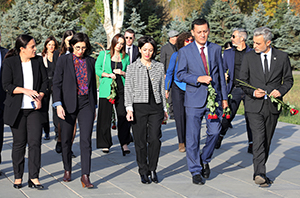
French Minister of Culture Rima Abdul Malak visited the Armenian Genocide Memorial Complex
26.10.2023
Rima Abdul Malak, Minister of Culture of France, who arrived in Armenia on an official visit, headed a delegation visiting the Armenian Genocide Memorial complex, accompanied by the Minister of Education, Science, Culture and Sports of the Republic of Armenia Zhanna Andreasyan, the Ambassador Extraordinary and Plenipotentiary of Armenia to France Hamik Tolmajian and the Ambassador Extraordinary and Plenipotentiary of France to Armenia Olivier Decotigny on October 26.
Edita Gzoyan, acting director of the Armenian Genocide Museum-Institute, welcomed the guests and presented the history of the creation of the Memorial complex. She then narrated the story of the three khachkars placed in Tsitsernakaberd in memory of the Armenians who died in the massacres organized by the government of Azerbaijan in the cities of Sumgait, Kirovabad (Gandzak) and Baku at the end of the 20th century, as well as the stories of the five freedom fighters buried in front of Memory Wall who died during the Artsakh struggle for survival, emphasizing the connection between the Armenian Genocide and contemporary acts of persecution and violence against Armenians. She also referred to the historical and legal aspects of the Artsakh issue and described Azerbaijan's anti-Armenian actions and propaganda.

Julien Zarifian's lecture titled "THE USA AND THE RECOGNITION OF THE ARMENIAN GENOCIDE"
26.10.2023
Julien Zarifian, professor of American history and civilization at the University of Poitiers, France and Member of the Institut Universitaire de France (IUF, 2020-2025), delivered a lecture titled "THE USA AND THE RECOGNITION OF THE ARMENIAN GENOCIDE" in the Armenian Genocide Museum-Institute’s conference hall on October 24.
Edita Gzoyan, acting director of the AGMI, first welcomed the attendees and briefly introduced Julien Zarifian.
During the lecture, Prof. Zarifian presented the factors and reasons determining US policy on recognizing the Armenian Genocide.

US Deputy Assistant Secretary of State overseeing policy for Southern Europe and the Caucasus Joshua Huck visited the Armenian Genocide Memorial complex
25.10.2023
Joshua Huck, US Deputy Assistant Secretary of State overseeing policy for Southern Europe and the Caucasus, visited the Armenian Genocide Memorial complex, accompanied by a group of employees of the US Embassy in Armenia, on October 25.
Edita Gzoyan, acting director of the Armenian Genocide Museum-Institute, welcomed the guests, presenting the history of the creation of the Memorial complex. She then narrated the history of the three khachkars placed in Tsitsernakaberd in memory of the Armenians who died in the massacres organized by the government of Azerbaijan in the cities of Sumgait, Kirovabad (Gandzak) and Baku at the end of the 20th century, as well as the stories of the five freedom fighters buried in front of the Memory Wall who died during the Artsakh struggle for survival, emphasizing the connection between the Armenian Genocide and contemporary acts of persecution and violence against Armenians. She also referred to the historical and legal aspects of the Artsakh issue and described Azerbaijan's anti-Armenian actions and propaganda.

Canadian Foreign Minister Mélanie Joly visited the Armenian Genocide Memorial complex
25.10.2023
Canadian Foreign Minister Mélanie Joly, who arrived in Armenia on an official visit, who led a delegation, visited the Armenian Genocide Memorial complex, accompanied by Armenian Foreign Minister Ararat Mirzoyan and Canada’s Ambassador Extraordinary and Plenipotentiary to Armenia Andrew Turner on October 25.
Edita Gzoyan, acting director of the Armenian Genocide Museum-Institute, welcomed the guests.
The ministers of the two countries laid wreaths at the memorial to the victims of the Armenian Genocide, after which the guests laid flowers at the Eternal Fire and observed a minute’s silence in memory of the innocent martyrs of the Armenian Genocide.

A FAREWELL MEETING WITH AGMI DIRECTOR HARUTYUN MARUTYAN
11.10.2023
The entire AGMI staff had a farewell meeting with its retired former director Harutyun Marutyun, whose five-year term of office ended on October 5. It took place in the AGMI conference hall on October 10.
He thanked everyone for their meritorious collective work of the past five years and said that after completing his term as director, he would be focusing on scientific activities, continuing his work at the Republic of Armenia’s National Academy of Sciences Institute of Archaeology and Ethnography (as the head researcher) and within the AGMI as a part-time head of department. The staff expressed their thanks and appreciation to him during the meeting, emphasising the AGMI’s achievements in all the areas of its activity during the last five years, greatly appreciating his merits in both human and work-related relationships and wishing him new scientific achievements.

International command and staff exercise at the AGMI complex
11.10.2023
An international command and staff exercise, in which rescuers from 7 countries participated, was held at the AGMI within the framework of the programme titled "Comprehensive Earthquake Management in Vulnerable Areas of the South Caucasus through Effective Planning, Response and Joint Actions" on October 10.
According to the scenario used, the Armenian Genocide Museum had been affected by an earthquake and had to be evacuated and museum visitors receive first aid. Secondly, museum objects had to be rescued by the fire-rescue squad and museum employees.
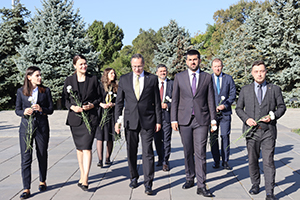
Mrs. Radvile Morkunaite Mikuleniene, Deputy Speaker of the Seimas of the Republic of Lithuania, visited the Armenian Genocide Memorial complex
06.10.2023
A delegation, led by Radvile Morkunaite Mikuleniene, Deputy Speaker of the Seimas of the Republic of Lithuania, visited the Armenian Genocide Memorial complex, accompanied by Sargis Khandanyan, Chairman of the NA Standing Committee on Foreign Relations, on October 6.
The delegation was greeted by Lusine Abrahamyan, AGMI Deputy Director for Museum Affairs, who narrated the history of the creation of the Memorial complex . She also presented the guests with the history of the three khachkars placed in the Tsitsernakaberd area in memory of the Armenians who died in the massacres in the cities of Sumgait, Kirovabad (Gandzak) and Baku in the last century organised by the Azerbaijani government, and the stories of the five freedom fighters buried in front of Memory Wall during the Artsakh war, emphasising the connection between what happened then and the Armenian Genocide.

The Most Reverend Justin Welby, Archbishop of Canterbury, visited the Armenian Genocide Memorial complex
05.10.2023
A delegation led by the Archbishop of Canterbury Justin Welby of the Anglican Church, visited the Armenian Genocide Memorial complex on October 5.
The guests were welcomed by Harutyun Marutyan, AGMI Director, who described the history of the creation of the Memorial complex. He then told the story of the three khachkars placed within the confines of Tsitsernakaberd in memory of the Armenians who died in the massacres organised by the government of Azerbaijan in the cities of Sumgait, Kirovabad (Gandzak) and Baku at the end of the 20th century, as well as the biographies of the five freedom fighters buried in front of Memory Wall during the Artsakh struggle for survival, emphasising that the contemporary acts of persecution and violence against Armenians were a continuation of the Armenian Genocide.

Ambassador Jaap Frederiks, Chargé d'affaires of the Kingdom of the Netherlands to Armenia, visited the Armenian Genocide Memorial
26.09.2023
Ambassador Jaap Frederiks, Chargé d'affaires of the Kingdom of the Netherlands to Armenia, visited the Armenian Genocide Memorial on September 26, accompanied by embassy staff.
The delegation was greeted by Lusine Abrahamyan, AGMI Deputy Director for Museum Affairs, who narrated the history of the creation of the Memorial. She also presented the guests with the history of the three khachkars placed in the Tsitsernakaberd area in memory of the Armenians who died in the massacres in the cities of Sumgait, Kirovabad (Gandzak) and Baku in the last century, organised by the Azerbaijani government. She also told the stories of the five freedom fighters buried in front of the Memory Wall during the Artsakh war, emphasising the connection between what happened then and the Armenian Genocide.

A delegation headed by Samantha Power, head of the US Agency for International Development, visited the Armenian Genocide Memorial
25.09.2023
A delegation headed by Samantha Power, head of the US Agency for International Development, visited the Armenian Genocide Memorial on September 25.
The guests were welcomed by Harutyun Marutyan, AGMI Director, who described the history of the creation of the Memorial complex. He then told the story of the three khachkars placed within the confines of Tsitsernakaberd in memory of the Armenians who died in the massacres organised by the Azerbaijani government in the cities of Sumgait, Kirovabad (Gandzak) and Baku at the end of the 20th century, as well as the biographies of the five freedom fighters buried in front of Memory Wall during the Artsakh struggle for survival, emphasising that contemporary acts of persecution and violence against Armenians were a continuation of the Armenian Genocide.
Samantha Power laid a wreath at the Genocide Monument, after which the accompanying guests laid flowers at the Eternal Fire and observed a minute’s silence in memory of the innocent martyrs of the Armenian Genocide.

A US congressional delegation visited the Armenian Genocide Memorial
24.09.2023
A US congressional delegation, led by US Senator Gerry Peters, visited the Armenian Genocide Memorial on September 24.
The guests were welcomed by Edita Gzoyan, AGMI Deputy Scientific Director, who presented the history of the creation of the Memorial complex. She then narrated the story of the three khachkars placed in Tsitsernakaberd in memory of the Armenians who died in the massacres organised by the government of Azerbaijan in the cities of Sumgait, Kirovabad (Gandzak) and Baku at the end of the 20th century, as well as the stories of the five freedom fighters buried in front of Memory Wall during the Artsakh struggle of survival, emphasising the connection between the Armenian Genocide and contemporary acts of persecution and violence against Armenians. Edita Gzoyan also referred to the historical and legal aspects of the Artsakh issue and presented Azerbaijan's anti-Armenian actions and propaganda.
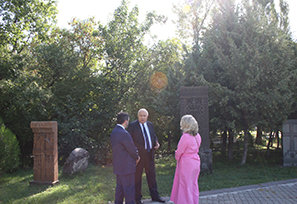
Andrius Pulokas, Ambassador Extraordinary and Plenipotentiary of the Republic of Lithuania to Armenia, visited the Armenian Genocide Memorial
20.09.2023
Andrius Pulokas, Ambassador Extraordinary and Plenipotentiary of the Republic of Lithuania, visited the Armenian Genocide Memorial on September 22.
The guests were welcomed by Harutyun Marutyan, AGMI Director, who described the history of the creation of the Memorial complex. He then told the story of the three khachkars placed within the confines of Tsitsernakaberd in memory of the Armenians who died in the massacres organised by the Azerbaijani government in the cities of Sumgait, Kirovabad (Gandzak) and Baku at the end of the 20th century, as well as the biographies of the five freedom fighters buried in front of Memory Wall during the Artsakh struggle for survival, emphasising that contemporary acts of persecution and violence against Armenians were a continuation of the Armenian Genocide.
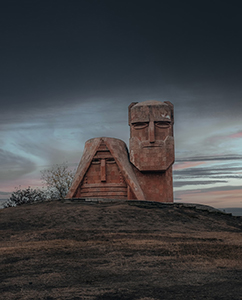
Save Artsakh
21.09.2023
On December 9, 1948 the international community decided to say “No” to the crime of genocide. Together with criminalizing genocidal acts, 153 state parties who had signed and ratified the Convention on the Prevention and Punishment of the Crime of Genocide (Genocide Convention) to date, have undertaken an obligation first to prevent and then only to punish the crime of genocide.
Article 1 of the Genocide Convention states that “The Contracting Parties confirm that genocide, whether committed in time of peace or in time of war, is a crime under international law which they undertake to prevent and to punish.”
In the case Concerning Application of the Convention on the Prevention and Punishment of the Crime of Genocide (Bosnia and Herzegovina v. Serbia and Montenegro), in its judgment the International Court of Justice ruled that state parties should “not wait until the perpetration of Genocide,” and explained the state-party obligation as one “to prevent or attempt to prevent the occurrence of the act.”
Unfortunately, 75 years later the modern civilization is silently witnessing another violent and brutal act of genocide, this time perpetrated against the Armenian population in Artsakh (Nagorno-Karabakh). After 9 months of blockade-resulted starvation and medical emergencies, the Armenians of Artsakh have entered a physical extermination stage of genocide being attacked by drones, airstrikes and mass shelling. There are deaths and wounded among the civilians, also children. Many are reported missing.

Rev. Dr. Jerry Pillay, Secretary General of the World Council of Churches, visited the Armenian Genocide Memorial
20.09.2023
The World Council of Churches delegation, led by its Secretary General Rev. Dr. Jerry Pillay, visited the Armenian Genocide Memorial on September 20, accompanied by the Vice Chairman of the Central Commission of the Council of Churches Archbishop Vigen Aikazyan.
The Secretary General of the World Council of Churches laid a wreath at the Genocide Monument, after which the guests laid flowers at the Eternal Fire and observed a minute’s silence in memory of the innocent martyrs of the Armenian Genocide.

Deputy Mayor of Nice Anthony Borré visited the Armenian Genocide Memorial
19.09.2023
On September 19, the delegation headed by the Deputy Mayor of Nice visited the Armenian Genocide Memorial, accompanied by the Ambassador Extraordinary and Plenipotentiary of France to Armenia, Olivier Decottignies.
The delegation was greeted by AGMI Senior tour guide Hasmik Martirosyan, who narrated the history of the creation of the Memorial. She also presented the guests with the history of the three khachkars placed in the Tsitsernakaberd area in memory of the Armenians who died in the massacres in the cities of Sumgait, Kirovabad (Gandzak) and Baku in the last century organised by the Azerbaijani government, and the stories of the five freedom fighters buried in front of Hushapat during the Artsakh war, emphasizing the connection between what happened and the Armenian Genocide.

The delegation of the Chamber of Deputies of the Czech Parliament visited the Armenian Genocide Memorial
19.09.2023
On September 19, the delegation led by the chairman of the Environment Committee of the Chamber of Deputies of the Czech Republic, Jana Krutáková, visited the Armenian Genocide Memorial, accompanied by the Chairman of the Standing Committee on Territorial Administration, Local Self-Government, Agriculture and Environmental Protection of the RA National Assembly, Vahe Ghalumyan, and Ambassador Extraordinary and Plenipotentiary Petr Pirunčík.
The delegation was greeted by Lusine Abrahamyan, the AGMI Deputy Director for Museum Affairs, who narrated the history of the creation of the Memorial. She also presented the guests with the history of the three khachkars placed in the Tsitsernakaberd area in memory of the Armenians who died in the massacres in the cities of Sumgait, Kirovabad (Gandzak) and Baku in the last century organised by the Azerbaijani government, and the stories of the five freedom fighters buried in front of Hushapat during the Artsakh war, emphasizing the connection between what happened and the Armenian Genocide.

Participants in the “Artsiv Partner-2023” Armenian-American military exercise visited the Armenian Genocide Memorial
16.09.2023
Participants in the “Artsiv Partner-2023” Armenian-American military exercise visited the Armenian Genocide Memorial On September 16.
The guests were welcomed by Harutyun Marutyan, AGMI Director, who described the history of the creation of the Memorial complex. He then told the story of the three khachkars placed within the confines of Tsitsernakaberd in memory of the Armenians who died in the massacres organised by the Azerbaijani government in the cities of Sumgait, Kirovabad (Gandzak) and Baku at the end of the 20th century, as well as the biographies of the five freedom fighters buried in front of Memory Wall during the Artsakh struggle for survival, emphasising that contemporary acts of persecution and violence against Armenians were a continuation of the Armenian Genocide.

SEPTEMBER 1918: MASSACRES OF BAKU ARMENIANS - 105
16.09.2023
The event titled "September 1918: Massacres of Baku Armenians - 105" was held in the "Armenian Genocide Museum-Institute" Foundation conference hall.
AGMI Director Harutyun Marutyan welcomed the audience with a speech. He introduced the speakers of the day then, referring to the topic, drew parallels with the genocidal policy being implemented by Azerbaijan in Artsakh today.
Professor Vahan Melikyan was the first speaker, presenting "The first Pan-Turkism incursion attempt in Baku in March 1918." He referred to the massacres in Baku in March and September of that year and the role played by the Young Turks in them.

Romano Prodi, former Prime Minister of Italy and former President of the European Commission visited the Armenian Genocide Memorial
14.09.2023
Romano Prodi, former Prime Minister of Italy (1996-1998, 2006-2008) and former President of the European Commission (1999-2004), visited the Armenian Genocide Memorial on September 14 accompanied by Tsovinar Hambardzumyan, RA Ambassador Extraordinary and Plenipotentiary to Italy, YSU Rector Hovhannes Hovhannisyan and YSU International Cooperation Department chief Alexander Margarov.
The delegation was greeted by Lusine Abrahamyan, AGMI Deputy Director for Museum Affairs, who narrated the history of the creation of the Memorial complex. She also presented the guests with the history of the three khachkars placed in the Tsitsernakaberd area in memory of the Armenians who died in the massacres in the cities of Sumgait, Kirovabad (Gandzak) and Baku in the last century organised by the Azerbaijani government, and the stories of the five freedom fighters buried in front of the Memorial Wall during the Artsakh war, emphasising the connection between what happened then and the Armenian Genocide.
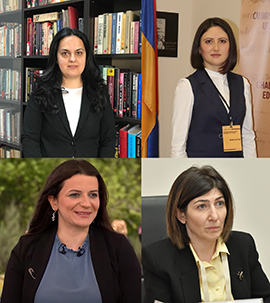
Article by the AGMI researchers Edita Gzoyan, Regina Galustyan, Shushan Khachatryan and Narine Margaryan was published in the prestigious "Journal of Genocide Research"
09.09.2023
Article by the AGMI researchers Edita Gzoyan, Regina Galustyan, Shushan Khachatryan and Narine Margaryan “In the Beautiful Heaven, a Golden Cage: Race, Identity and Memory in Turkification of Armenian Children in State Orphanages during the Armenian Genocide” was published in the prestigious Journal of Genocide Research (Impact Factor 1.5, 1 Quartile).
Building on existing research, this article first presents the ideological foundations of Turkish nation-building and the implementation of the Armenian Genocide to achieve this end, focusing on the forcible transfer and assimilation which selected Armenian children endured.
Informed by both published and unpublished memories of transferred children, the second part of the article reconstructs the actual process and methods of Turkification used in several state-run orphanages while also presenting the resistance of Armenian children to these efforts.
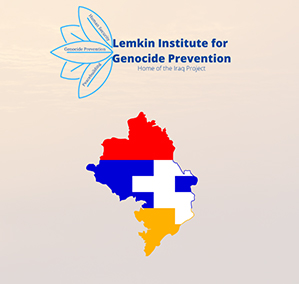
Risk Factors and Indicators of the Crime of Genocide in the Republic of Artsakh:
Lemkin Institute's report
06.09.2023
On September 5, 2023, the Lemkin Institute released a 126-page report “Risk Factors and Indicators of the Crime of Genocide in the Republic of Artsakh: Applying the UN Framework of Analysis for Atrocity Crimes to the Nagorno-Karabakh Conflict.”
The evidence presented in the Report suggests “that the crime of genocide may already be taking place in the form of the blockade, which is both “Causing serious bodily or mental harm to members of the group” and “[d]eliberately inflicting on the group conditions of life calculated to bring about its physical destruction in whole or in part” (paragraphs II.b. and II.c. of the 1948 Genocide Convention).”

Strasbourg Mayor Jeanne Barseghian visited the Armenian Genocide Memorial
01.09.2023
Strasbourg Mayor Jeanne Barseghian, who arrived in Armenia to deliver humanitarian aid to Artsakh as part of a delegation led by Paris Mayor Anne Hidalgo, visited the Armenian Genocide Memorial on August 31.
The guests were welcomed by Harutyun Marutyan, AGMI Director, who described the history of the creation of the Memorial complex. He then told the story of the three khachkars placed within the confines of Tsitsernakaberd in memory of the Armenians who died in the massacres organised by the Azerbaijani government in the cities of Sumgait, Kirovabad (Gandzak) and Baku at the end of the 20th century, as well as the biographies of the five freedom fighters buried in front of Memory Wall during the Artsakh struggle for survival, emphasising that contemporary acts of persecution and violence against Armenians were a continuation of the Armenian Genocide.

PRELIMINARY OPINION on the situation in Nagorno-Karabakh and on the need for the international community to adopt measures to prevent atrocity crimes
01.09.2023
On August 23, 2023 Juan Mendez, Former Special Advisor to the Secretary-General on the Prevention of Genocide (2004-2007), Professor of Human Rights Law in Residence, Commissioner, International Commission of Jurists, Former UN Special Rapporteur on Torture (2010-16) provided a PRELIMINARY OPINION on the situation in Nagorno-Karabakh and on the need for the international community to adopt measures to prevent atrocity crimes.
Under the circumstances, it is my considered opinion that the facts outlined above constitute sufficient reason to proffer an early warning to the international community that the population of Nagorno-Karabakh is at risk of suffering “serious bodily or mental harm to members of the group” (Article 2, paragraph b of the Convention on the Prevention and Punishment of Genocide).
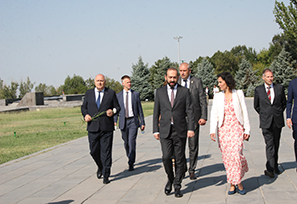
Belgian Foreign Minister Hadja Lahbib visited the Armenian Genocide Memorial
22.08.2023
On August 22, the delegation headed by the Minister of Foreign Affairs, European Affairs and Foreign Trade, Federal Cultural Institutions of the Kingdom of Belgium Hadja Lahbib, who arrived in Armenia on an official visit, visited the Armenian Genocide Memorial, accompanied by RA Minister of Foreign Affairs Ararat Mirzoyan, RA Ambassador Extraordinary and Plenipotentiary to Belgium Anna Aghajanyan.
The guests were welcomed by Harutyun Marutyan, director of the Armenian Genocide Museum-Institute.

Memorial week dedicated to the Assyrian Genocide
15.08.2023
This year, for the first time, a series of events, dedicated to the memory of the victims of the Assyrian Genocide that had been organised in the Ottoman Empire, took place from August 7 to 11, through the initiative of Armenian Genocide Museum-Institute.
A commemoration ceremony was held at the Assyrian Genocide Monument in Yerevan in memory of the innocent victims of the Assyrian Genocide on August 7. Members of the Assyrian community of Armenia were present, as were Suren Manukyan, head of the AGMI V. Dadrian Department of Comparative Genocide Studies and others.

The Assyrian Genocide:
Memorial Day and R. Lemkin's reference
12.08.2023
It was not just the Armenians that became victims of the genocidal policy implemented by the Ottoman Empire during the First World War; the other Christian minorities within the empire, Greeks and Assyrians, as well as Yezidis, were too.
August 7 was chosen as Memorial Day for the victims of the Assyrian Genocide, being officially announced as Assyrian Martyrs' Day in 1970. A great massacre of Assyrians took place in the Kurdish village of Simel in northern Iraq, which had been resettled by refugees in 1915, on that very day in 1933.
According to some researchers, 3,000 Assyrians were burned alive in two Christian churches in just one day. Around 100 Assyrian villages in the surrounding area were also destroyed and looted and 6,000 Assyrian men, women and children were killed. Tens of thousands of Assyrians were displaced by force.

Pan-Armenian Games participants visited the Armenian Genocide Memorial
11.08.2023
Around 6,500 participants of the 8th Pan-Armenian Games visited the Armenian Genocide Memorial complex on August 11.
The participants visited Tsitsernakaberd with the President of the Republic of Armenia Vahagn Khachaturyan, Chairman of the Pan-Armenian Games World Committee Ishkhan Zakaryan, deputies Roland Sharoyan, Stepan Der-Bedrosyan and other members of the Pan-Armenian Games Executive Committee. The guests were accompanied by AGMI Director Harutyun Marutyan.
Wreaths were placed at the memorial to the victims of the Armenian Genocide on behalf of the President of the Republic of Armenia and the Chairman of the World Committee of the Pan-Armenian Games, after which the participants of the 8th Pan-Armenian Games placed flowers near the Eternal Fire and observed a minute’s silence in memory of the innocent martyrs of the Armenian Genocide. The guests then toured the Armenian Genocide Museum and became acquainted with its permanent and temporary exhibitions.

Prominent genocide scholars have submitted an open letter to the UN Secretary-General, the UN High Commissioner for Human Rights, the Special Adviser of the UN Secretary-General on the Prevention of Genocide, and Member States of the UN Security Council regarding the potential for genocide in Artsakh (Nagorno-Karabakh)
11.08.2023
We, the undersigned scholars and experts on genocide, are writing to you with an overwhelming sense of urgency and concern about the potential for genocide in the Republic of Artsakh (also known as the Nagorno Karabakh Republic). As scholars deeply engaged in the study of genocide, we bear witness to the horrors of history, rigorously analyze past and present atrocities, working to prevent new genocides from occurring. Presently, we find ourselves profoundly concerned by the emergence of unmistakable warning signs of genocide in Artsakh. The most significant risk factor is the unlawful blockade of the Lachin Corridor, which serves as the vital link connecting Artsakh to Armenia.
Since December 2022, the Lachin Corridor, the sole lifeline connecting the Artsakh population to the outside world, has been unlawfully blockaded by Azerbaijani authorities. This distressing situation reached a critical juncture on June 15, 2023, when Azerbaijan sealed off this vital road, subjecting the Republic of Artsakh and its 120,000 residents to a dire state of siege. For the past two months, Artsakh has been forcibly deprived of its ability to access essential supplies such as food, medicine, and other critical goods.

Representatives of the staff of the US Senate Committee on Foreign Relations visited the Armenian Genocide Memorial
09.08.2023
Sarah Arkin and Damian Murphy, staff representatives of the US Senate Foreign Relations Committee, who are currently in Armenia on the instructions of Senator Robert Menendez, the chairman of this committee, visited the Armenian Genocide Memorial complex on August 9.
The guests were welcomed by Harutyun Marutyan, AGMI Director, who described the history of the creation of the Memorial complex. He then told the story of the three khachkars placed within the confines of Tsitsernakaberd in memory of the Armenians who died in the massacres organised by the Azerbaijani government in the cities of Sumgait, Kirovabad (Gandzak) and Baku at the end of the 20th century, as well as the biographies of the five freedom fighters buried in front of Memory Wall during the Artsakh struggle for survival, emphasising that contemporary acts of persecution and violence against Armenians were a continuation of the Armenian Genocide.

EXPERT OPINION: GENOCIDE AGAINST ARMENIANS IN 2023
By the former ICC prosecutor Luis Moreno Ocampo
09.08.2023
The blockade of the Lachin Corridor by Azerbaijan that impedes access to any food, medical supplies, and other essentials to Nagorno-Karabakh is a Genocide against the ethnic Armenians of Nagorno-Karabakh under Article II, (c) of the Genocide Convention: “Deliberately inflicting on the group conditions of life calculated to bring about its physical destruction.”
There are no crematories, and there are no machete attacks. Starvation is the invisible Genocide weapon. Without immediate dramatic change, this group of Armenians will be destroyed in a few weeks.
In many respects, the starvation of the ethnic Armenians of Nagorno-Karabakh represents the archetype of genocide through the imposition of conditions of life designed to bring about a group’s destruction. It closes a tragic circle because “[t]he treatment of the Armenians by the Turkish rulers in 1915 provides the paradigm for the Genocide provision dealing with imposition of conditions of life.”

Empty Discrepancy or False Dilemma: Territorial integrity vs. Self-determination in the Case of Artsakh
08.08.2023
The two international law principles that are constantly used within the Artsakh/ Nagorno Karabakh/ case are self-determination and territorial integrity.
Territorial integrity and self-determination of nations are two principles of the international law, which raise many debates because of a supposed contradiction. Territorial integrity refers to the protection of an independent state’s territory from aggression of other states, while self-determination is defined as a right of nations to freely decide their sovereignty and political status without external compulsion or outside interference. Thus, territorial integrity is closely connected with a basic order in interstate relations among sovereign independent states, while self-determination is a fundamental human right and refers to the relations between an independent state and a people.

Press Release
01.08.2023
On 1 August 2023, the Armenian Genocide Museum-Institute, in collaboration with the UNESCO Department on Prevention of Genocide and Other Atrocity Crimes at Yerevan State University and a number of civil society organizations from the Republic of Artsakh, submitted an application to Ms. Alice Wairimu Nderitu, the Special Adviser of the UN Secretary-General on the Prevention of Genocide.
Alongside the application, a comprehensive report was submitted to the Special Adviser, detailing the international crimes perpetrated in Artsakh as a direct consequence of the illegal blockade of the Berdzor (Lachin) Corridor in the Republic of Artsakh. The report specifically delves into the extensive and grave violations of human rights and international humanitarian law committed by Azerbaijan and its representatives, based on ethnic origin. The report strongly asserts that since its inception the blockade of the Berdzor (Lachin) Corridor has constituted an international crime, specifically classified as a crime against humanity.

The RA Ministry of Education and Culture has approved the use of the course presented by the “Armenian Genocide Museum-Institute” Foundation titled “Basic Problems of the Armenian Genocide”
25.07.2023
A resolution was adopted, within the framework of the three-day conference titled "Challenges of Teaching the Armenian Genocide in the 21st Century," organised by the AGMI on April 20-22 last year, that stated that the participants of the conference, emphasising the re-evaluation of past experience and the teaching of the history of the Armenian Genocide, found that it was imperative to create and teach a course on "Basic Problems of the Armenian Genocide," in both public and higher education institutions. (The full text of the resolution may be found at http://www.genocide-museum.am/arm/13.05.22.php . Therefore, thanks to the consistent work carried out by the AGMI Directorate, a professional group was formed, by order of the Minister of Education and Culture of the Republic of Armenia, which held working discussions on this subject for several months. As a result of this, the programme for the course on the subject of "Basic Problems of the Armenian Genocide" was prepared, the use of which was approved by Janna Andreasyan, RA ESCS Minister, by order No. 878-A/2 of June 13, 2023.

“TEACHING THE TOPIC OF THE ARMENIAN GENOCIDE”
The 5th teachers’ summer school
21.07.2023
The Armenian Genocide Museum-Institute hosted a three-day summer school titled “Teaching the Topic of the Armenian Genocide,” which this year was implemented in collaboration with The Genocide Education Project (GenEd) on July 19-21.
More than 30 Armenian history teachers from Yerevan and the regions participated, which was held for the fifth year.
The summer school was launched by AGMI Director Harutyun Marutyun, who, in his welcoming speech, emphasised the importance of teachers’ participation in such educational programmes and the transfer of their acquired knowledge and skills to their students.

THE ARMENIAN GENOCIDE MUSEUM-INSTITUTE’S AMERICAN TEACHERS’ TRAINING PROGRAMME WAS COMPLETED
18.07.2023
The American “Genocide Education Project” (GenEd) organisation, in cooperation with the Armenian Genocide Museum-Institute, organised a training programme for 15 American teachers on July 9-14, 2023. It took place for the second time taking the suggestions and wishes of the 2022 participants into account.
The training took place, in the form of lectures and practical training, at the Armenian Genocide Museum-Institute. The topic of the Armenian Genocide was presented to the participants from historical, legal and socio-psychological perspectives, as well as showing the state impunity it enjoys and the Turkish denial and long-term impact of that crime on the current political and economic situation around the Republic of Armenia.

Cardinal Pietro Parolin, Vatican Secretary of State, visited the Armenian Genocide Memorial
12.07.2023
The delegation, led by Cardinal Pietro Parolin, Vatican Secretary of State, visited the Armenian Genocide Memorial accompanied by Paruyr Hovhannisyan, RA Deputy Foreign Minister and Karen Nazaryan, RA Ambassador Extraordinary and Plenipotentiary to the Holy See, on July 12.
The guests were welcomed by Harutyun Marutyan, AGMI Director, who described the history of the creation of the Memorial. He then told the story of the three khachkars placed at Tsitsernakaberd in memory of the Armenians who died in the massacres organised by the Azerbaijani government in the cities of Sumgait, Kirovabad (Gandzak) and Baku at the end of the 20th century, as well as the biographies of the five freedom fighters buried in front of Memory Wall during the Artsakh struggle of survival, emphasising the connection between the Armenian Genocide and contemporary acts of persecution and violence against Armenians.

IN MEMORY OF RICHARD HOVANNISIAN
11.07.2023
The world-famous scientist and historian Richard Hovannisian passed away at the age of 90 in Los Angeles, USA on July 10.
Richard G. Hovhannisian was born in the small settlement of Tulare near Fresno, California, USA, into a family of Armenian Genocide survivors from Kharberd. He grew up in an environment where memories of the genocide were both subjects of everyday conversation and repressed memory. He said that although the elders did not talk much about the Genocide in his presence, fragmentary evidence, such as the terrifying tattoos on the hands and faces of Armenian women, which were made as a result of their being kidnapped during the deportation, accompanied little Richard all the time.
Hovannisian was a historian and received his first degree at the University of California, in Berkeley in 1954. Later on, he continued his studies at University of California, in Los Angeles (UCLA), where he received a doctorate for the study of the creation and fate of the First Republic of Armenia of 1918-1920 in 1966. This study later became the basis of his book “Armenia on the Road to Independence” and the foundation of his monumental four-volume work on the history of the first republic of Armenia.

VOLUNTEERS AT THE AGMI: DAVID R. HACKETT - THE AGMI’S “AMBASSADOR OF THE MEMORY OF THE ARMENIAN GENOCIDE”
08.07.2023
The Armenian Genocide Museum-Institute is launching and putting into practice a new project, appointing an “Ambassador of the Memory of the Armenian Genocide”. This idea is closely related to the urgent agenda of collecting memories of the Armenian Genocide. The Armenian Genocide memory ambassador is the person who collects preserved memories of the Armenian Genocide from different parts of the world and transfers them to the Armenian Genocide Museum-Institute.
The first Armenian Genocide memory ambassador is David Hackett, the great-grandson of Armenian Genocide survivor Varter Poghosyan. He graduated from the University of Massachusetts (Boston, USA) with a major in international relations in 2022 and is now a Ph.D. student at Columbia University. David did volunteer work at the AGMI (editing English texts) in February-May of this year under the “Birthright Armenia” programme.
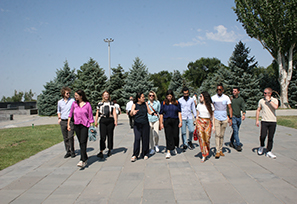
Students of the Geneva Academy of International Humanitarian Law and Human Rights visited the Armenian Genocide Memorial
04.07.2023
Students of the Geneva Academy of International Humanitarian Law and Human Rights visited the Armenian Genocide Memorial on July 4 in the frames of a study visit to Armenia.
The guests were welcomed by Edita Gzoyan, AGMI Deputy Scientific Director, who presented the history of the creation of the Memorial. She then presented the story of the three khachkars placed at Tsitsernakaberd in memory of the Armenians who died in the massacres organized by the Azerbaijani government in the cities of Sumgait, Kirovabad (Gandzak) and Baku at the end of the 20th century, as well as the stories of the five freedom fighters buried in front of Hushapat during the Artsakh struggle of survival—these components of the Memorial emphasize the connection between the Armenian Genocide and contemporary acts of persecution and violence against Armenians. Edita Gzoyan also referred to the historical and legal aspects of the Artsakh issue, presented Azerbaijan's anti-Armenian actions and propaganda. She presented also about Hushapat, the reverse side of which contains, in special niches which house small jugs, soil from the graves of a number of foreign public figures, politicians, intellectuals, dignitaries and missionaries who raised their voices in protest against the widespread massacres and deportations of Armenians carried out by the Turkish governments in the late 19th and early 20th centuries.

The delegation of the Ministry of Foreign Affairs of the Republic of India visited the Armenian Genocide Memorial
04.07.2023
The delegation of the Ministry of Foreign Affairs of the Republic of India visited the Armenian Genocide Memorial on July 4.
The delegation was greeted by Lusine Abrahamyan, the AGMI Deputy Director for Museum Affairs, who narrated the history of the creation of the Memorial. She also presented the guests with the history of the three khachkars placed in the Tsitsernakaberd area in memory of the Armenians who died in the massacres in the cities of Sumgait, Kirovabad (Gandzak) and Baku in the last century organised by the Azerbaijani government, and the stories of the five freedom fighters buried in front of Hushapat during the Artsakh war, emphasizing the connection between what happened and the Armenian Genocide.

The delegation of the US State Department visited the Armenian Genocide Memorial
01.07.2023
On June 30, Ambassador James O’Brien, Head of the Office of Sanctions Coordination at the U.S. State Department, and Kumar Iyer, Director General, Economics, Science and Technology at the UK Foreign, Commonwealth & Development Office, visited the Armenian Genocide Memorial. The delegation was accompanied by John Gallagher, UK Ambassador to Armenia.
The guests were welcomed by Edita Gzoyan, AGMI Deputy Scientific Director, who presented the history of the creation of the Memorial. She then presented the story of the three khachkars placed at Tsitsernakaberd in memory of the Armenians who died in the massacres organized by the Azerbaijani government in the cities of Sumgait, Kirovabad (Gandzak) and Baku at the end of the 20th century, as well as the stories of the five freedom fighters buried in front of Hushapat during the Artsakh struggle of survival—these components of the Memorial emphasize the connection between the Armenian Genocide and contemporary acts of persecution and violence against Armenians. Edita Gzoyan also referred to the historical and legal aspects of the Artsakh issue, presented Azerbaijan's anti-Armenian actions and propaganda.

The newly appointed Ambassador of the Republic of Poland to the Republic of Armenia Piotr Skwieciński visited the Armenian Genocide Memorial
29.06.2023
On June 28, the newly appointed Ambassador of the Republic of Poland to the Republic of Armenia Piotr Skwieciński and other employees of the embassy visited the Armenian Genocide Memorial.
The guests were welcomed by Edita Gzoyan, AGMI Deputy Scientific, who presented the history of the creation of the Memorial. She then presented the story of the three khachkars placed at Tsitsernakaberd in memory of the Armenians who died in the massacres organized by the Azerbaijani government in the cities of Sumgait, Kirovabad (Gandzak) and Baku at the end of the 20th century, as well as the stories of the five freedom fighters buried in front of Hushapat during the Artsakh struggle of survival—these components of the Memorial emphasize the connection between the Armenian Genocide and contemporary acts of persecution and violence against Armenians. Edita Gzoyan also referred to the historical and legal aspects of the Artsakh issue, presented Azerbaijan's anti-Armenian actions and propaganda.

Executive Director of Europol Catherine De Bolle visited the Armenian Genocide Memorial
28.06.2023
On June 28, the delegation led by the Executive Director of the European Union Law Enforcement Cooperation Agency (Europol) Catherine De Bolle visited the Armenian Genocide Memorial, accompanied by the RA Minister of Internal Affairs Vahe Ghazaryan and RA Ambassador Extraordinary and Plenipotentiary to the Kingdom of the Netherlands Tigran Balayan.
The delegation was greeted by Lusine Abrahamyan, the AGMI Deputy Director for Museum Affairs, who narrated the history of the creation of the Memorial. She also presented the guests with the history of the three khachkars placed in the Tsitsernakaberd area in memory of the Armenians who died in the massacres in the cities of Sumgait, Kirovabad (Gandzak) and Baku in the last century organised by the Azerbaijani government, and the stories of the five freedom fighters buried in front of Hushapat during the Artsakh war, emphasizing the connection between what happened and the Armenian Genocide.

Laura Kelly, the governor of the state of Kansas, USA, visited the Armenian Genocide Memorial
22.06.2023
On June 22, the delegation led by the governor of the state of Kansas, Laura Kelly, visited the Armenian Genocide Memorial, accompanied by the Deputy Minister of Defense of the Republic of Armenia, Arman Sargsyan. US Brigadier General Michael Venerdi, Commander of the Kansas National Guard, was also part of the American delegation.
The guests were welcomed by Edita Gzoyan, AGMI Deputy Director for Scientific Work, who presented the history of the creation of the Memorial. She then presented the story of the three khachkars placed at Tsitsernakaberd in memory of the Armenians who died in the massacres organized by the Azerbaijani government in the cities of Sumgait, Kirovabad (Gandzak) and Baku at the end of the 20th century, as well as the stories of the five freedom fighters buried in front of Hushapat during the Artsakh struggle of survival—these components of the Memorial emphasize the connection between the Armenian Genocide and contemporary acts of persecution and violence against Armenians. Edita Gzoyan also referred to the historical and legal aspects of the Artsakh issue, presented Azerbaijan's anti-Armenian actions and propaganda.
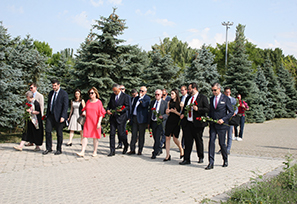
The delegation of the European Parliament visited the Armenian Genocide Memorial
20.06.2023
On June 20, the EP delegation visited the Armenian Genocide Memorial, accompanied by the Chairman of the Standing Committee on European Integration of the RA National Assembly, Arman Yeghoyan, and the Head of the EU Delegation to Armenia, Ambassador Andrea Victorin.
The delegation was greeted by Lusine Abrahamyan, the AGMI Deputy Director for Museum Affairs, who narrated the history of the creation of the Memorial. She also presented the guests with the history of the three khachkars placed in the Tsitsernakaberd area in memory of the Armenians who died in the massacres in the cities of Sumgait, Kirovabad (Gandzak) and Baku in the last century organised by the Azerbaijani government, and the stories of the five freedom fighters buried in front of Hushapat during the Artsakh war, emphasizing the connection between what happened and the Armenian Genocide.

The delegation of the American "Philos Project" organization visited the Armenian Genocide Memorial
16.06.2023
The delegation headed by Robert Nicholson, head of the American "Philos Project" organization, visited the Armenian Genocide Memorial on June 15.
Former US ambassador for international religious freedom, the 46th governor of Kansas Sam Brownback was part of the delegation.
The guests were welcomed by Edita Gzoyan, AGMI Deputy Director for Scientific Work, who presented the history of the creation of the Memorial. She then presented the story of the three khachkars placed at Tsitsernakaberd in memory of the Armenians who died in the massacres organized by the Azerbaijani government in the cities of Sumgait, Kirovabad (Gandzak) and Baku at the end of the 20th century, as well as the stories of the five freedom fighters buried in front of Hushapat during the Artsakh struggle of survival—these components of the Memorial emphasize the connection between the Armenian Genocide and contemporary acts of persecution and violence against Armenians.

AGMI researcher has been awarded an Armenian National Science and Education Foundation (ANSEF) grant
13.06.2023
The project proposed by Naira Sahakyan, senior researcher in the Department of Armenian Repression in Artsakh, Nakhichevan and Azerbaijan’s Armenian regions of the Armenian Genocide Museum-Institute Foundation, was recognised as the winner of the academic research competition held by the Armenian National Science and Education Fund. This project in the field of humanities is implemented in cooperation with the support programme for young scientists of the Science Committee of the RA Ministry of Science, Education, Sports and Culture.
Naira Sahakyan (together with Turkologist Anahit Kartashyan) will study the changes to the narrative of the Artsakh war seen in the speeches made by the leaders of Armenia, Azerbaijan and Turkey in 1991-2002.
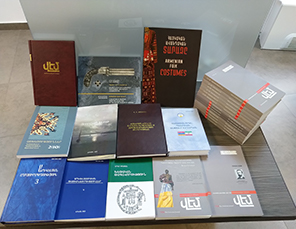
New additions to the AGMI library
09.06.2023
Thanks to the tradition of cooperation between the AGMI and various scientific structures in Armenia, the AGMI library has been enriched with about 120 books and journals in recent years. A significant number of these are the issues of “Vem,” the Pan-Armenian quarterly journal received from the ARF History Museum (around 105 issues). Valuable publications have also been donated by the History Museum of Armenia and the Republic of Armenia’s National Academy of Sciences Institute of Oriental Studies.
All these books and journals have found their places in the AGMI library and will serve both the institute staff as well as reading room visitors.

NEW HOMELAND
The history of the expatriated Armenians in Greece
06.06.2023
The screening of the full-length documentary film “New Homeland,” by the Greek director Konstantinos Georgopoulos, was held at the “Danaos” cinema in Athens on May 12, 13 and 14.
The film covers the emigration of Armenians to Greece in the 1920s as well as their resettlement and subsequent life in different regions of the country. It was screened within the framework of the Thessaloniki Documentary Film Festival.
The film is the first historical overview of the Armenian community that took shape in Greece; the life of the Armenian exiles, after the Armenian Genocide and the Asia Minor catastrophe, is addressed (approximately 100 thousand Armenians were expatriated to Greece after 1922).

Memorial week dedicated to the Greek Genocide
02.06.2023
A series of events dedicated to the memory of the victims of the Greek Genocide organised in the Ottoman Empire took place from May 19 to 27 thanks to the initiative of AGMI and with the participation of the Greek community in Armenia.
Flowers were laid at the memorial stone in the yard of the Greek Centre in the town of Alaverdi took place, followed by a prayer by Rev. Mikael Shaghoyan, pastor of the Alaverdi community, in memory of the martyred Greeks on May 19.
The event was attended by Arkadi Tamazyan, head of the Alaverdi community, Emmanuel Asimakopoulos, the Greek Consul in Armenia, Suren Manukyan, head of the AGMI Dadrian Department of Comparative Genocide Studies, members of the Greek community of Armenia and others.
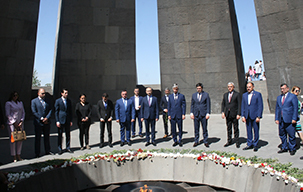
Mayor of Rostov-On-Don Alexey Logvinenko visited the Armenian Genocide Memorial
01.06.2023
On May 30, the delegation led by the Mayor of Rostov-On-Don, Alexey Logvinenko, visited the Armenian Genocide Memorial, accompanied by the Deputy Mayor of Yerevan, Stepan Machyan, and the heads of three factions of the Council of Elders.
The guests were welcomed by the Edita Gzoyan, AGMI Deputy Director for Scientific Work, who presented the history of the creation of the Memorial. He then presented the story of the three khachkars placed at Tsitsernakaberd in memory of the Armenians who died in the massacres organized by the Azerbaijani government in the cities of Sumgait, Kirovabad (Gandzak) and Baku at the end of the 20th century, as well as the stories of the five freedom fighters buried in front of Hushapat during the Artsakh struggle of survival—these components of the Memorial emphasize the connection between the Armenian Genocide and contemporary acts of persecution and violence against Armenians.

The President of the Argentina-Armenia Friendship Group of the Senate of Argentina, Guillermo Andrada, visited the Armenian Genocide Memorial
31.05.2023
On May 30, the delegation led by the president of the Argentina-Armenia friendship group of the Senate of the Republic of Argentina, Guillermo Andrada, visited the Armenian Genocide Memorial, accompanied by the head of the RA NA Armenia-Argentina friendship group Ishkhan Saghatelyan, group members Elinar Vardanyan, Hasmik Hakobyan, Arman Ghazaryan and Sergey Bagratyan.
The delegation was greeted by Lusine Abrahamyan, the AGMI Deputy Director for Museum Affairs, who narrated the history of the creation of the Memorial. She also presented the guests with the history of the three khachkars placed in the Tsitsernakaberd area in memory of the Armenians who died in the massacres in the cities of Sumgait, Kirovabad (Gandzak) and Baku in the last century organised by the Azerbaijani government, and the stories of the five freedom fighters buried in front of Hushapat during the Artsakh war, emphasizing the connection between what happened and the Armenian Genocide.

Speaker of the National Assembly of Slovenia Urška Klakočar Zupancic visited the Armenian Genocide Memorial
30.05.2023
On May 30, the delegation led by the Speaker of the National Assembly of Slovenia, Urška Klakočar Zupancic, visited the Armenian Genocide Memorial, accompanied by RA NA Deputy Speaker Hakob Arshakyan, Head of RA NA Armenia-Slovenia Friendship Group Seyran Ohanyan, group member Mariam Poghosyan and RA Ambassador Extraordinary and Plenipotentiary to Slovenia Ashot Hovakimyan.
The delegation was greeted by Lusine Abrahamyan, the AGMI Deputy Director for Museum Affairs, who narrated the history of the creation of the Memorial. She also presented the guests with the history of the three khachkars placed in the Tsitsernakaberd area in memory of the Armenians who died in the massacres in the cities of Sumgait, Kirovabad (Gandzak) and Baku in the last century organized by the Azerbaijani government, and the stories of the five freedom fighters buried in front of Hushapat during the Artsakh war, emphasizing the connection between what happened and the Armenian Genocide.
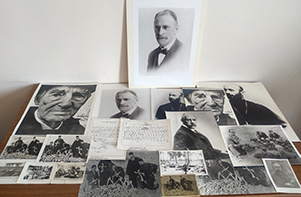
STATEMENT
27.05.2023
The “Armenian Genocide Museum-Institute” Foundation (AGMI) states that the papers in the boxes seen in the video broadcast on the Internet today are only drafts of working copies of items used in exhibitions, conferences and lectures organised by the AGMI in various years.
The AGMI will, in the near future, be issuing a request to the author to refute the video and we urge those spreading it not to spread unverified information.

VAHAKN DADRIAN 97
On the occasion of the birthday of the famous Genocide scholar
26.05.2023
The employees of the Armenian Genocide Museum-Institute today paid a visit to the grave of the world-renowned Armenian Genocide scholar Vahakn Dadrian.
May 26 is Vahakn Norair Dadrian’s birthday. He was a famous Armenian scientist, prominent Genocide scholar and a famous scholar of the history of the Armenian Genocide. He was a descendant of Armenian Genocide survivors. His family, having survived the Armenian Genocide and following the path of exile, first settled in Damascus. The family then moved to Constantinople, where his father, Hagop Dadrian, married for the second time and where Vahakn Norair Dadrian was born on 26 May 1926.
Vahakn’s childhood memory held stories of Armenian women that, having survived the Armenian Genocide, would gather on various occasions for secret conversations in which the terrifying word “massacre” was constantly heard. He was, however, unaware at that time of what had happened because there was an accepted habit of not raising this topic within Armenian families in Constantinople. This was also because mention of the Armenian Genocide was officially forbidden in Kemalist Turkey.

ANNOUNCEMENT
“Teaching the Topic of the Armenian Genocide” Educational Programme
V Summer School for Teachers
25.05.2023
The “Armenian Genocide Museum-Institute” Foundation is organising a three-day summer school for teachers teaching Armenian history titled “Teaching the topic of the Armenian Genocide,” on July 19-21, 2023.
This summer school may be attended by public middle and high school Armenian history teachers, who should apply justifying the importance of their participation in the programme.
Application responses will be given at least 3 weeks prior to the start of the summer school.

TREE PLANTING IN THE ARMENIAN GENOCIDE MEMORIAL AREA AND THE OPENING OF THE RENOVATED AGMI COLLECTIONS STORE
With the support of the Central Board of the Ramgavar Party
25.05.2023
Trees were planted on an area of the Armenian Genocide Memorial Complex on the initiative of the Armenian Genocide Museum-Institute (AGMI) directorate and with the assistance of the Central Board of the Armenian Democratic Liberal Party – Ramgavar (ADL) on May 23. They were planted in an area of about 7,000 square metres and more will be planted on another 1.5 hectares in the future. Participants involved were members of Ramgavar Party, AGMI employees, as well as students and teachers of the following Yerevan schools: the Vardanants Aspetner No. 106, Gagik Stepanyan No. 135, Ashot Navasardyan No. 196, Lev Tolstoy No. 128 and the Artashes Shahinyan Physical and Mathematical Special School.
However, before the actual tree planting began, members of the ADL laid a wreath at the memorial to the victims of the Armenian Genocide, then placed flowers near the Eternal Fire and observed a minute’s silence in memory of the innocent victims of the Armenian Genocide.
Dear visitor,
The Armenian Genocide Museum will be closed on May 28, 2023.
Sincerely,
The Armenian Genocide Museum-Institute Foundation

UK Parliamentary Under-Secretary of State for Europe Leo Docherty visited the Armenian Genocide Memorial
23.05.2023
The delegation led by the Parliamentary Under-Secretary (Foreign, Commonwealth and Development Office) Leo Docherty visited the Armenian Genocide Memorial on May 22, accompanied by the RA Deputy Foreign Minister Paruyr Hovhannisyan.
The guests were welcomed by the AGMI Director Harutyun Marutyan, who presented the history of the creation of the Memorial. He then presented the story of the three khachkars placed at Tsitsernakaberd in memory of the Armenians who died in the massacres organized by the Azerbaijani government in the cities of Sumgait, Kirovabad (Gandzak) and Baku at the end of the 20th century, as well as the stories of the five freedom fighters buried in front of Hushapat during the Artsakh struggle of survival—these components of the Memorial emphasize the connection between the Armenian Genocide and contemporary acts of persecution and violence against Armenians.

CONCENTRATION CAMPS DURING THE ARMENIAN GENOCIDE։ ROAD TO THE DEATH
Conference Invitation
19.05.2023
Date: 18-20 September 2023
Conference venue: Armenian Genocide Museum-Institute, Yerevan
Organizer: Armenian Genocide Museum-Institute Foundation
The first “concentration camps” emerged at the end of the 19th century. The Spanish introduced camps in Cuba, the United States in the Philippines, the British in the South African Republic (Transvaal), and, later, the Germans in German Southwest Africa. The camps were used to target a wide range of persons in large-scale conflicts.

Armenian Genocide Museum-Institute (AGMI) researcher Narek Poghosyan participated in the international conference, dedicated to the Genocide of the people of Kurdistan, titled “On the Genocide of the Feyli Kurds” held in Erbil, Iraqi Kurdistan
18.05.2023
Armenian Genocide Museum-Istitute (AGMI) researcher Narek Poghosyan participated in the international conference dedicated to the Genocide of the people of Kurdistan titled “On the Genocide of the Feyli Kurds” held in Erbil, Iraqi Kurdistan, from 2nd to the 4th May.
A top committee, consisting of the leadership of the Saladin, Soran, and Dohuk universities in Iraqi Kurdistan, was formed to arrange and hold this conference. Over 160 short and 88 research reports from 25 countries were presented during its three days.
Various reports were presented during the conference concerning the actions taken by Saddam Hussein's regime against the Kurds and, especially, about the crimes committed against the Feyli (Shia) Kurds in 1980, when thousands of them were deported from Iraq to Iran or killed and their property confiscated.
Narek Poghosyan gave a report on genocide studies, as well as a comparative analysis of the Armenian genocide and the genocidal actions committed against the Kurds, particularly of the Anfal operations.
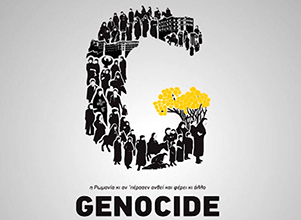
Schedule of events dedicated to the memory of the Greek Genocide
(Organized in cooperation with the Greek community in Armenia)
17.05.2023
May 19
12:00 - Laying a wreath in memory of the victims of the Genocide of Greeks in Alaverdi, commemoration event, Alaverdi Greek Center.
May 20
11:00 – Laying a wreath at the Eternal Fire of Tsitsernakaberd.
The presentation of the book “The Genocide of the Ottoman Greeks: Reports from the U.S. Press (1913-1922),” compiled by Ara Ketibyan, at the Conference Hall of the Armenian Genocide Museum-Institute.

Summary of the work of the three-day international conference titled “Children and Nation: Forcible Child Transfer and Genocide Convention through Historical and Contemporary Lenses”
16.05.2023
The three-day international conference titled Children and Nation: Forcible Child Transfer and Genocide Convention through Historical and Contemporary Lenses, was held from May 14 to 16 2023.
The conference was opened with a welcoming speech by AGMI Director Harutyun Marutyan, who said “There is a well-known phrase: ‘Children are our future.’ It’s a wonderful concept. However, this fact is not only known by people of good will, but also by leaders of totalitarian and authoritarian regimes. In the case of totalitarian regimes, such as the Young Turk and Nazi regimes in the 20th century, they either carried out the mass extermination the young generation of the people targeted or tried to assimilate them into their ranks.”
Felix Berry, coordinator of the Canadian Museum of Human Rights and Genocide Scholar Donna-Lee Frieze, a representative of the Contemporary Histories Research Group of Deakin University, Australia, the co-organisers of the conference, welcomed the attendees. They both said that they were happy that this conference was taking place, as it had been planned to be held in 2020 but, due to the COVID-19 pandemic, had been postponed.

The delegation of the V. Brusov State University and the University of Bucharest visited the Armenian Genocide Memorial
11.05.2023
The students of V. Brusov State University and Bucharest University visited the Armenian Genocide Memorial on May 11, led by the Dean of the Faculty of Political Science of the University of Bucharest, Member of the European Parliament for 2009-2019 Christian Preda and the Rector of V. Brusov State University Davit Gyurjinyan. The delegation also included representatives of the International Organization of Francophonie.
The guests were welcomed by the AGMI Director Harutyun Marutyan, who presented the history of the creation of the Memorial. He then presented the story of the three khachkars placed at Tsitsernakaberd in memory of the Armenians who died in the massacres organized by the Azerbaijani government in the cities of Sumgait, Kirovabad (Gandzak) and Baku at the end of the 20th century, as well as the stories of the five freedom fighters buried in front of Hushapat during the Artsakh struggle of survival—these components of the Memorial emphasize the connection between the Armenian Genocide and contemporary acts of persecution and violence against Armenians.

International Conference at AGMI
07.05.2023
On May 13-15, an international conference “CHILDREN AND NATION: FORCIBLE CHILD TRANSFER AND GENOCIDE CONVENTION THROUGH HISTORICAL AND CONTEMPORARY LENSES” will be held in the AGMI Conference Hall.
The conference is organized by the Armenian Genocide Museum-Institute, the Canadian Museum for Human Rights and the Modern History Research Group of Deakin University, Australia.
You can find the conference program and information about speakers at the conference website:
https://childandnationconf.am.

THE GLORIFICATION AND HERO-WORSHIP OF THE YOUNG TURK ORGANISERS OF THE ARMENIAN GENOCIDE IN REPUBLICIAN TURKEY: MEHMED TALAAT
06.05.2023
The Turkish authorities, adhering to the policy of denying the genocide carried out by the Young Turks, try to avoid condemning the crime that was committed and confronting their own past by falsifying history and covering up historical facts in every possible way.
Great Britain, France and Russia issued a joint statement regarding the deportation and massacres of the Armenian population of the Ottoman Empire on May 24, 1915, describing them as crimes against humanity. This statement on bringing the perpetrators of the Armenian Genocide to justice had its logical continuation immediately after the First World War. Within the framework of the Paris Peace Conference, the first international body investigating war crimes was established on January 25, 1919. This was the Commission on the Responsibility and Punishment of the Authors of War. This body was supposed to find out who unleashed the First World War and to impose punishments on those who committed war crimes.
The commission was also presented with a list of perpetrators of crimes against Armenians, in which Enver, Jemal and Talaat Pasha were among the main culprits who were recognised as being responsible for war crimes and crimes against the laws of humanity. The commission, after studying much evidence that had been obtained, stated that during the war, Turkey had committed gross violations of the rights of soldiers and citizens, which were against the laws and customs of war, as well as the laws of humanity and that the individuals who were guilty of these violations should be prosecuted.

Xavier Bertrand, the President of the Hauts-de-France Regional Council of France, visited the Armenian Genocide Memorial
03.05.2023
On May 3, the delegation headed by Xavier Bertrand, the chairman of the Hauts-de-France Regional Council of France, visited the Armenian Genocide Memorial, accompanied by the Armenian Ambassador Extraordinary and Plenipotentiary to France Hasmik Tolmajyan.
The guests were welcomed by the AGMI Director Harutyun Marutyan, who presented the history of the creation of the Memorial. He then presented the story of the three khachkars placed at Tsitsernakaberd in memory of the Armenians who died in the massacres organized by the Azerbaijani government in the cities of Sumgait, Kirovabad (Gandzak) and Baku at the end of the 20th century, as well as the stories of the five freedom fighters buried in front of Hushapat during the Artsakh struggle of survival—these components of the Memorial emphasize the connection between the Armenian Genocide and contemporary acts of persecution and violence against Armenians.

Galina Izotova, the President of the Accounts Chamber of the Russian Federation, visited the Armenian Genocide Memorial
02.05.2023
Galina Izotova, the President of the Accounts Chamber of the Russian Federation, visited the Armenian Genocide Memorial on May 2 together with her family members.
The guests were welcomed by the AGMI Director Harutyun Marutyan, who presented the history of the creation of the Memorial. He then presented the story of the three khachkars placed at Tsitsernakaberd in memory of the Armenians who died in the massacres organized by the Azerbaijani government in the cities of Sumgait, Kirovabad (Gandzak) and Baku at the end of the 20th century, as well as the stories of the five freedom fighters buried in front of Hushapat during the Artsakh struggle of survival—these components of the Memorial emphasize the connection between the Armenian Genocide and contemporary acts of persecution and violence against Armenians.

Minister of Europe and Foreign Affairs of France Catherine Colonna paid tribute to the memory of the martyrs of the Armenian Genocide
27.04.2023
On April 27, the delegation led by the Minister of Europe and Foreign Affairs of France, Catherine Colonna, visited the Armenian Genocide Memorial, accompanied by RA Minister of Foreign Affairs Ararat Mirzoyan, RA Ambassador Extraordinary and Plenipotentiary to France Hasmik Tolmajian, and France's Ambassador Extraordinary and Plenipotentiary to Armenia Anne Luo.
The guests were welcomed by AGMI Director Harutyun Marutyan.
The Ministers laid wreaths at the Genocide monument, after which the guests put flowers at the Eternal Fire and observed a minute’s silence in memory of the innocent martyrs of the Armenian Genocide.

The head of the “Republicans” faction of the French Senate, Bruno Retailleau, visited the Armenian Genocide Memorial
24.04.2023
On April 24, the delegation headed by the leader of the “Republicans” faction in the Senate of the Republic of France, the founder and chairman of the Senate group on Nagorno Karabakh, Bruno Retailleau, visited the Armenian Genocide Memorial, accompanied by the chairman of the RA NA Standing Committee on Foreign Relations, Sargis Khandanyan.
The guests were welcomed by AGMI Director Harutyun Marutyan.
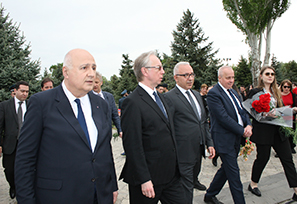
Deputy Foreign Minister of the Russian Federation Mikhail Galuzin visited the Armenian Genocide Memorial
24.04.2023
On April 24, the delegation led by Russian Deputy Foreign Minister Mikhail Galuzin visited the Armenian Genocide Memorial, accompanied by RA Deputy Foreign Minister Mnatsakan Safaryan and Russian Ambassador Extraordinary and Plenipotentiary to RA Sergey Kopirkin.
The guests were welcomed by AGMI Director Harutyun Marutyan.

Catholicos of All Armenians paid tribute to the memory of the Martyrs of the Armenian Genocide
24.04.2023
On April 24, His Holiness Garegin II, Supreme Patriarch and Catholicos of All Armenians, visited the Tsitsernakaberd memorial complex to commemorate the holy martyrs of the Armenian Genocide. He was accompanied by congregants of the Mother See of Holy Etchmiadzin.
After placing a wreath at the memorial complex, His Holiness performed an intercession service dedicated to the holy martyrs of the Armenian Genocide in front of the Eternal Fire.
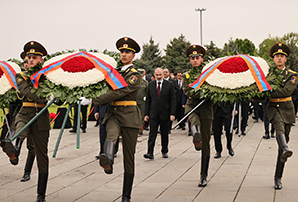
Government officials and public servants of the Republic of Armenia paid tribute to the memory of the victims of the Armenian Genocide
24.04.2023
President of the Republic Vahagn Khachaturyan, Prime Minister Nikol Pashinyan, Speaker of the National Assembly Alen Simonyan, and other National Assembly deputies, other members of the government, and the heads of diplomatic missions accredited in Armenia, among others, paid tribute to the victims of the Armenian Genocide at the Tsitsernakaberd memorial complex on April 24 in commemoration of Armenian Genocide Remembrance Day.
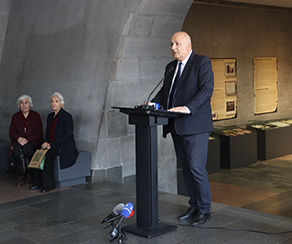
“MELKON COULD NOT BE NEJIB... FORCIBLE CHILD TRANSFER DURING THE ARMENIAN GENOCIDE”- The Opening of a New Exhibition at the Armenian Genocide Museum-Institute
22.04.2023
On April 21st, this year’s temporary exhibition was opened at the Armenian Genocide Museum-Institute: “Melkon could not be Nejib...Forcible child transfer the Armenian Genocide.” This opening ceremony was attended by the Extraordinary and Plenipotentiary Ambassador of the Syrian Arab Republic Nora Arisyan, President of AGBU Armenia Vasken Yacoubian, Director of the National Archives of Armenia Artur Stepanyan, President of the “Pyunik” Foundation Gabriel Chamberjian, and Perchuhi Postaljian—the daughter of survivor and author Yervand Postaljian, one of the Armenian orphans of the Turkish orphanage of Adana—in addition to professors, students and other attendees from around the globe.
AGMI Director Harutyun Marutyan welcomed the audience, noting that this exhibition would highlight a particularly cruel element of the atrocities committed against Armenians to its audience: the trauma incurred and shouldered by Armenian children during the Armenian Genocide.
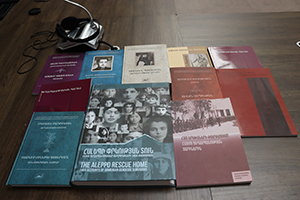
The presentation of new publications of AGMI took place
22.04.2023
On April 19th, the Armenian Genocide Museum-Institute presented eight new books and two journal editions.
Director of the Armenian Genocide Museum-Institute Harutyun Marutyan noted that the works all focus on the Armenian Genocide and instrumentalize unique sources in furnishing their work: most notably, the memoirs of survivors, survivor testimonies and studies on the policy of Turkification of Armenian children during the Armenian Genocide. Marutyan further added: “The second issue of the 2022 English-language scientific periodical of the International Journal of Armenian Genocide Studies, published by the AGMI, is entirely dedicated to different aspects of Artsakh issue and the genocidal policy implemented by Azerbaijan towards Armenians. This publication is important precisely because it represents a way to render the crisis in Artsakh accessible to the general public beyond Armenia in an accessible language.”

Mayor of Lyon Gregory Doucet visited the Armenian Genocide Memorial
11.04.2023
On April 10, the delegation led by the mayor of Lyon, Gregory Doucet, visited the Armenian Genocide Memorial, accompanied by the deputy mayor of Yerevan, Suren Grigoryan, and the heads of fractions of the Yerevan Council of Elders.
The guests were welcomed by the AGMI Director Harutyun Marutyan, who presented the history of the creation of the Memorial. He then presented the story of the three khachkars placed at Tsitsernakaberd in memory of the Armenians who died in the massacres organized by the Azerbaijani government in the cities of Sumgait, Kirovabad (Gandzak) and Baku at the end of the 20th century, as well as the stories of the five freedom fighters buried in front of Hushapat during the Artsakh struggle of survival—these components of the Memorial emphasize the connection between the Armenian Genocide and contemporary acts of persecution and violence against Armenians.
Dear visitor,
The Armenian Genocide Museum will be closed on April 9, 2023.
Sincerely,
The Armenian Genocide Museum-Institute Foundation
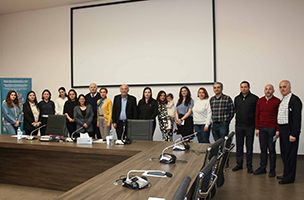
“SCHOLARS FOR SCHOLARS”: PROFESSOR BARLOW DER MUGRDECHIAN AWARD FOR AGMI RESEARCHERS
07.04.2023
On the initiative of Professor Barlow Der Mugrdechian, Director of Armenian Studies, California State University, Fresno, for the third time, AGMI researchers were awarded in the best article, monograph, and collection of articles, book chapters and other nominations. This year, the author of the initiative, Barlow Der Mugrdechian, personally handed out the awards in the conference hall of AGMI.
AGMI Director, Dr. Harutyun Marutyan thanked Barlow Der Mugrdechian for being by the side and supporting AGMI.
The third “Scholars for Scholars” Der Mugrdechian Awards were presented in four categories.

The delegation of the Seimas of Lithuania visited the Armenian Genocide Memorial
05.04.2023
The delegation of the Seimas of the Republic of Lithuania visited the Armenian Genocide Memorial on April 5, accompanied by RA NA MPs Heriknaz Tigranyan, Lilit Stepanyan and Gayane Yeghiazaryan.
The delegation was greeted by Lusine Abrahamyan, the AGMI Deputy Director for Museum Affairs, who narrated the history of the creation of the Memorial. She also presented the guests with the history of the three khachkars placed in the Tsitsernakaberd area in memory of the Armenians who died in the massacres in the cities of Sumgait, Kirovabad (Gandzak) and Baku in the last century organised by the Azerbaijani government, and the stories of the five freedom fighters buried in front of Hushapat during the Artsakh war, emphasizing the connection between what happened and the Armenian Genocide.

Marian Carey, Chairman of the Foreign Relations Committee of the Slovak National Council, visited the Armenian Genocide Memorial
04.04.2023
On April 4, the delegation headed by Marian Carey, the chairman of the Foreign Relations Committee of the National Council of the Slovak Republic, visited the Armenian Genocide Memorial, accompanied by Sargis Khandanyan, the Chairman of the RA NA Standing Committee on Foreign Relations, and Miroslav Hatsek, the Ambassador Extraordinary and Plenipotentiary of Slovakia to the Republic of Armenia.
The delegation was greeted by Lusine Abrahamyan, the AGMI Deputy Director for Museum Affairs, who narrated the history of the creation of the Memorial. She also presented the guests with the history of the three khachkars placed in the Tsitsernakaberd area in memory of the Armenians who died in the massacres in the cities of Sumgait, Kirovabad (Gandzak) and Baku in the last century organised by the Azerbaijani government, and the stories of the five freedom fighters buried in front of Hushapat during the Artsakh war, emphasizing the connection between what happened and the Armenian Genocide.
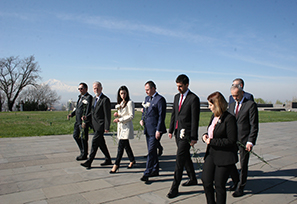
Members of the Croatia-Armenia Friendship Group of the Croatian Parliament visited the Armenian Genocide Memorial
04.04.2023
On April 4, the delegation led by Davor Ivo Stier, head of the Croatia-Armenia Friendship Group of the Croatian Parliament, visited the Armenian Genocide Memorial, accompanied by Hayk Mamijanyan, the head of the Armenia-Croatia Friendship Group of the RA NA.
The delegation was greeted by Lusine Abrahamyan, the AGMI Deputy Director for Museum Affairs, who narrated the history of the creation of the Memorial. She also presented the guests with the history of the three khachkars placed in the Tsitsernakaberd area in memory of the Armenians who died in the massacres in the cities of Sumgait, Kirovabad (Gandzak) and Baku in the last century organised by the Azerbaijani government, and the stories of the five freedom fighters buried in front of Hushapat during the Artsakh war, emphasizing the connection between what happened and the Armenian Genocide.

Members of the Poland-Armenia Friendship Group of the Polish Parliament visited the Armenian Genocide Memorial
02.04.2023
On April 2, the delegation led by the head of the Poland-Armenia Friendship Group of the Polish Parliament, Radoslaw Fogiel, visited the Armenian Genocide Memorial, accompanied by the head of the RA NA Armenia-Poland Friendship Group, Arusiak Julhakyan, and the Ambassador Extraordinary and Plenipotentiary of Poland to the Republic of Armenia, Pawel Chieplak.
The delegation was greeted by Lusine Abrahamyan, the AGMI Deputy Director for Museum Affairs, who narrated the history of the creation of the Memorial. She also presented the guests with the history of the three khachkars placed in the Tsitsernakaberd area in memory of the Armenians who died in the massacres in the cities of Sumgait, Kirovabad (Gandzak) and Baku in the last century organised by the Azerbaijani government, and the stories of the five freedom fighters buried in front of Hushapat during the Artsakh war, emphasizing the connection between what happened and the Armenian Genocide.

Members of the Sweden-Armenia friendship group of the Swedish Parliament visited the Armenian Genocide Memorial
01.04.2023
On April 1, the delegation led by the head of the Sweden-Armenia friendship group of the Swedish Parliament, Björn Söder, visited the Armenian Genocide Memorial, accompanied by the member of the RA NA Armenia-Sweden friendship group, MP Lilit Minasyan.
The delegation was greeted by Lusine Abrahamyan, the AGMI Deputy Director for Museum Affairs, who narrated the history of the creation of the Memorial. She also presented the guests with the history of the three khachkars placed in the Tsitsernakaberd area in memory of the Armenians who died in the massacres in the cities of Sumgait, Kirovabad (Gandzak) and Baku in the last century organised by the Azerbaijani government, and the stories of the five freedom fighters buried in front of Hushapat during the Artsakh war, emphasizing the connection between what happened and the Armenian Genocide.

Mexican senators visited the Armenian Genocide Memorial
01.04.2023
Mexican senators Alejandra del Carmen León Gastélum, Cecilia Margarita Sanes García and Indira Kempis Martínez visited the Armenian Genocide Memorial on April 1, accompanied by Honorary Consul of Mexico in Armenia Nikolay Kostandyan.
The guests were welcomed by AGMI Director Harutyun Marutyan, who narrated the history of the creation of the Memorial. He also presented the guests with the history of the three khachkars placed in the Tsitsernakaberd area in memory of the Armenians who died in the massacres in the cities of Sumgait, Kirovabad (Gandzak) and Baku in the last century organised by the Azerbaijani government, and the stories of the five freedom fighters buried in front of Hushapat during the Artsakh war, emphasizing the connection between what happened and the Armenian Genocide.

Laurent Wauquiez, President of the Auvergne-Rhone-Alpes Region of France, visited the Armenian Genocide Memorial
31.03.2023
On March 31, the delegation led by the President of the Auvergne-Rhone-Alpes Region of France, Laurent Wauquiez, visited the Armenian Genocide Memorial, accompanied by the RA Deputy Foreign Minister Paruyr Hovhannisyan and RA Ambassador Extraordinary and Plenipotentiary to France Hasmik Tolmajyan.
The guests were welcomed by AGMI Director Harutyun Marutyan, who narrated the history of the creation of the Memorial. He also presented the guests with the history of the three khachkars placed in the Tsitsernakaberd area in memory of the Armenians who died in the massacres in the cities of Sumgait, Kirovabad (Gandzak) and Baku in the last century organised by the Azerbaijani government, and the stories of the five freedom fighters buried in front of Hushapat during the Artsakh war, emphasizing the connection between what happened and the Armenian Genocide.

The delegation of the RF Federal Assembly visited the Armenian Genocide Memorial
17.03.2023
On March 16, the delegation headed by the Deputy Chairman of the Federation Council of the RF Federal Assembly, Yuri Vorobyov, who arrived in Armenia to participate in the 36th session of the Inter-Parliamentary Commission on Cooperation between the RA National Assembly and the RF Federal Assembly, visited the Armenian Genocide Memorial. Accompanied by Hakob Arshakyan, co-chairman of the inter-parliamentary commission on cooperation between the RF Federal Assembly, Vagharshak Harutyunyan, RA ambassador extraordinary and plenipotentiary to Russia, and Sergey Kopirkin, RF ambassador extraordinary and plenipotentiary to RA.
The guests were greeted by AGMI Director Harutyun Marutyan.

The Iraq-Armenia friendship group visited the Armenian Genocide Memorial
14.03.2023
On March 14, the Armenian Genocide Museum-Institute welcomed the Iraq-Armenia Friendship delegation of the House of Representatives of the Republic of Iraq, chaired by Mohammed Khoshnau, to the Armenian Genocide Memorial.
The delegation was greeted by Lusine Abrahamyan, the AGMI Deputy Director for Museum Affairs, who presented the history of the Memorial’s establishment and creation. She then presented the story of the three khachkars placed at Tsitsernakaberd in memory of the Armenians who died in massacres organized by the Azerbaijani government in the cities of Sumgait, Kirovabad (Gandzak), and Baku during the 20th century—this component of the Memorial emphasizes the connection between the Armenian Genocide and contemporary acts of persecution and violence against Armenians.
Dear visitor,
The Armenian Genocide Museum-Institute will be closed on March 8, 2023.
Sincerely,
The Armenian Genocide Museum-Institute Foundation

The newly appointed Ambassador of Mexico to Armenia, Eduardo Villegas Mejias, visited the Armenian Genocide Memorial
04.03.2023
Newly appointed Ambassador of Mexico to Armenia Eduardo Villegas Mejias (residence: Moscow) visited the Armenian Genocide Memorial on March 4, accompanied by Honorary Consul of Mexico to Armenia Nikolay Kostandyan.
The guests were welcomed by AGMI Senior guide Hasmik Martirosyan, who narrated the history of the creation of the Memorial. She also presented the guests with the history of the three khachkars placed in the Tsitsernakaberd area in memory of the Armenians who died in the massacres in the cities of Sumgait, Kirovabad (Gandzak) and Baku in the last century organised by the Azerbaijani government, and the stories of the five freedom fighters buried in front of Hushapat during the Artsakh war, emphasizing the connection between what happened and the Armenian Genocide.

Deputy Speaker of the Chamber of Deputies of the Grand Duchy of Luxembourg Djuna Bernard visited the Armenian Genocide Memorial
28.02.2023
On February 28, the delegation led by Deputy Speaker of the Chamber of Deputies of the Grand Duchy of Luxembourg, Deputy Chairman of the Bureau of the Chamber, Djuna Bernard, visited the Armenian Genocide Memorial, accompanied by Sona Ghazaryan, head of the Armenia-Luxembourg Friendship Group of the RA NA, and Tigran Balayan, RA Ambassador Extraordinary and Plenipotentiary to the Grand Duchy of Luxembourg.
The guests were welcomed by AGMI Director Harutyun Marutyan, who narrated the history of the creation of the Memorial. He also presented the guests with the history of the three khachkars placed in the Tsitsernakaberd area in memory of the Armenians who died in the massacres in the cities of Sumgait, Kirovabad (Gandzak) and Baku in the last century organised by the Azerbaijani government, and the stories of the five freedom fighters buried in front of Hushapat during the Artsakh war, emphasizing the connection between what happened and the Armenian Genocide.
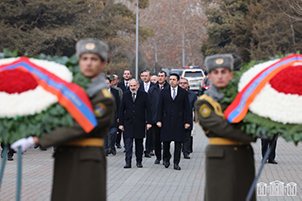
RA high-ranking officials paid tribute to the victims of the Sumgait massacres
27.02.2023
On the 35th anniversary of the mass massacre of Armenians carried out in 27-29 February, 1988, in the city of Sumgait, Azerbaijan, delegation led by Prime Minister Nikol Pashinyan, Speaker of the National Assembly Alen Simonyan, President of the Republic Vahagn Khachaturyan and members of the Security Council visited the Tsitsernakaberd Memorial to pay tribute to the victims of the Sumgait crime.
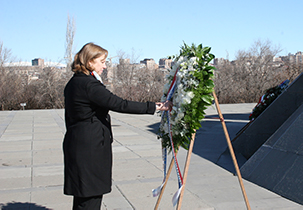
The newly appointed US Ambassador Kristina Kvien visited the Armenian Genocide Memorial
24.02.2023
The newly appointed US Ambassador Extraordinary and Plenipotentiary to Armenia Kristina Kvien visited the Armenian Genocide Memorial on February 24.
The guests were welcomed by AGMI Director Harutyun Marutyan, who narrated the history of the creation of the Memorial. He also presented the guests with the history of the three khachkars placed in the Tsitsernakaberd area in memory of the Armenians who died in the massacres in the cities of Sumgait, Kirovabad (Gandzak) and Baku in the last century organised by the Azerbaijani government, and the stories of the five freedom fighters buried in front of Hushapat during the Artsakh war, emphasizing the connection between what happened and the Armenian Genocide.

Italian Minister of Culture Gennaro Sangiuliano visited the Armenian Genocide Memorial
22.02.2023
On 22 February, the delegation led by the Minister of Culture of Italy Gennaro Sangiuliano visited the Armenian Genocide Memorial accompanied by Alfred Kocharian, Deputy Minister of the RA ESCS, Arkadi Papoyan, Head of the Department of Foreign Relations and Diaspora, RA Ambassador Extraordinary and Plenipotentiary to Italy Tsovinar Hambardzumyan, and Italian Ambassador Extraordinary and Plenipotentiary to RA Alfonso Di Rizzo.
The guests were welcomed by AGMI Director Harutyun Marutyan, who narrated the history of the creation of the Memorial. He also presented the guests with the history of the three khachkars placed in the Tsitsernakaberd area in memory of the Armenians who died in the massacres in the cities of Sumgait, Kirovabad (Gandzak) and Baku in the last century organised by the Azerbaijani government, and the stories of the five freedom fighters buried in front of Hushapat during the Artsakh war, emphasizing the connection between what happened and the Armenian Genocide.
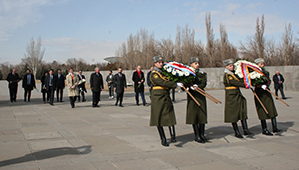
Minister of Foreign and European Affairs of the Grand Duchy of Luxembourg Jean Asselborn visited the Armenian Genocide Memorial
22.02.2023
The delegation headed by the Minister of Foreign and European Affairs of the Grand Duchy of Luxembourg, Jean Asselborn, who arrived in Armenia on an official visit, visited the Armenian Genocide Memorial on February 22, accompanied by RA Minister of Foreign Affairs Ararat Mirzoyan.
The guests were welcomed by AGMI Director Harutyun Marutyan.
The Ministers laid wreaths at the Genocide monument, after which the guests put flowers at the Eternal Fire and observed a minute’s silence in memory of the innocent martyrs of the Armenian Genocide.

The former Prime Minister of France, currently the Mayor of Havre, Edouard Philippe, visited the Armenian Genocide Memorial
22.02.2023
On February 21, the delegation led by the former Prime Minister of France, currently the Mayor of Le Havre, Mr. Edouard Philippe, and the former Minister, currently the Member of the European Parliament, Ms. Nathalie Loiseau, visited the Armenian Genocide Memorial, accompanied by the Ambassador Extraordinary and Plenipotentiary of France to Armenia, Mrs. Anne Luo.
The guests were welcomed by AGMI Director Harutyun Marutyan, who narrated the history of the creation of the Memorial. He also presented the guests with the history of the three khachkars placed in the Tsitsernakaberd area in memory of the Armenians who died in the massacres in the cities of Sumgait, Kirovabad (Gandzak) and Baku in the last century organised by the Azerbaijani government, emphasizing the connection between what happened and the Armenian Genocide.

Deputies of the European Parliament visited the Armenian Genocide Memorial
21.02.2023
French MPs of the European Parliament, co-chairs of the friendship group with Artsakh in the Council of Europe Sylvie Guillaume and François Alphonse visited the Armenian Genocide Memorial on February 21, accompanied by Gaspar Karapetyan, the president of the European office of the Armenian Revolutionary Federation Hay Dat/Armenian Cause, Heghine Evinyan, the director of the same office, and Gevorg Ghukasyan, the head of the special programs of Hay Dat Central Office.
The guests were welcomed by AGMI Director Harutyun Marutyan, who narrated the history of the creation of the Memorial. He also presented the guests with the history of the three khachkars placed in the Tsitsernakaberd area in memory of the Armenians who died in the massacres in the cities of Sumgait, Kirovabad (Gandzak) and Baku in the last century organised by the Azerbaijani government, emphasizing the connection between what happened and the Armenian Genocide.

ORPHANS’ FATHER HOVHANNES TOUMANYAN
Today marks the 154 anniversary of the great Armenian poet– Hovhannes Tumanyan
19.02.2023
The life of the poet concerned with the fate of his nation was also paralleled with active public-political activities. Hovhannes Toumanyan's orphan care activities during and after the Armenian Genocide deserves a special attention.
At the end of July 1915, news arrived about the flow of thousands of refugees to Igdir and Echmiadzin. In July 30 Toumanyan arrived in Echmiadzin with his daughter Nvard, where masses of Armenians, survivors of the Armenian Genocide were gathered. Toumanyan was immediately engaged in a work to provide shelter to the migrants, take care of orphans and provide them with food. Under his direct leadership fundraising was organized, a hospital with 500 beds and an orphanage for 3000 orphans was opened.
In parallel to orphan care works, Hovh. Toumanyan was recruiting orphans from suburbs of Echmiadzin accommodating them in orphanages. He was personally making lists of sick and healthy children providing special treatment to sick Armenian orphans.

Mexican Senate recognizes Armenian Genocide
10.02.2023
The Mexican Senate (Senate of the Republic) adopted a document on February 8 recognizing the Armenian Genocide, citing the need for protection of universal human rights.
At the same time, the Senate calls on the Secretariat of Foreign Affairs to support the official recognition of the Armenian Genocide by Mexico.

Croatian Foreign Minister Gordan Grlić Radman’s visit to the Armenian Genocide Memorial
08.02.2023
On January 19, the delegation led by the Minister of Foreign and European Affairs of the Republic of Croatia, Gordan Grlić Radman, who arrived in Armenia on an official visit, visited the Armenian Genocide Memorial, accompanied by Deputy Foreign Minister of the Republic of Armenia Paruyr Hovhannisyan, Ambassador Extraordinary and Plenipotentiary of the Republic of Armenia to Croatia Ashot Hovakimyan, and Ambassador Extraordinary and Plenipotentiary of Croatia to the Republic of Armenia Aleksandar Sunko.
The guests were welcomed by AGMI Director Harutyun Marutyan, who narrated the history of the creation of the Memorial. He also presented the guests with the history of the three khachkars placed in the Tsitsernakaberd area in memory of the Armenians who died in the massacres in the cities of Sumgait, Kirovabad (Gandzak) and Baku in the last century organised by the Azerbaijani government.

International Association of Genocide Scholars Executive and Advisory Boards:
Statement Condemning the Azerbaijani Blockade of the Artsakh (Nagorno-Karabakh)
03.02.2023
The International Association of Genocide Scholars (IAGS) Executive and Advisory Boards strongly condemns Azerbaijan’s blockade of Artsakh (Nagorno-Karabakh) and the ongoing aggression against the indigenous Armenian population of the region and warns of the risk of genocide against the Armenian population of that entity. We reaffirm the IAGS Executive Board October 24, 2022 “Statement on Azerbaijani Aggression Against the Republic of Armenia and the Indigenous Armenians of the South Caucasus” and call for the immediate lifting of the blockade.
On December 12, 2022 the government of Azerbaijan imposed a blockade on the enclave of Artsakh (Nagorno-Karabakh) creating an ongoing humanitarian crisis for its 120,000 Armenian inhabitant, including 30,000 children and 20,000 elderly.
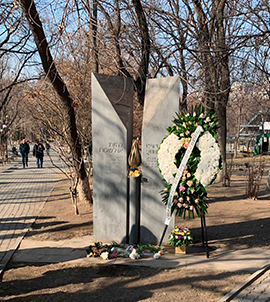
“Holocaust Remembrance Week” at the Armenian Genocide Museum-Institute
02.02.2023
For the fourth year in a row starting in 2020, the Armenian Genocide Museum-Institute has organised the “Holocaust Remembrance Week” series of events on the occasion of the International Holocaust Remembrance Day (January 27), at the end of January.
This year, the series of events started on January 27, with the commemoration of the innocent genocide victims at the Holocaust and Genocide Victims Monument. The event was attended by representatives of Armenia’s Jewish community, led by its head, Rima Varzhapetyan; the director of the “Armenian Genocide Museum-Institute” Foundation Harutyun Marutyan; Vardan Astsatryan, the Head of the Department of National Minorities and Religion of the RA Government and others. In his speech near the monument, AGMI director Harutyun Marutyan said: “Auschwitz-Birkenau was liberated 78 years ago on this day, January 27 and this very day was declared, by the United Nations in 2005, as International Holocaust Remembrance Day. There are not many survivors of the Holocaust after 78 years and the Jews can learn from the Armenians how to preserve and pass on the memory of the genocide to future generations. Today, the victims of the Holocaust are remembered here not only by the Jewish community of Armenia, but also by the Republic of Armenia itself. It is important, however, not to confuse the commemoration of the Holocaust with the politics of the State of Israel. At the moment, 120,000 of our compatriots are under siege in Artsakh as a result of Azerbaijan government policy and it is appropriate to note that two dozen Jewish scientists, journalists and activists sent a letter to the Israeli Foreign Minister, asking for help to prevent a humanitarian disaster in Artsakh.”
Dear visitor,
The Armenian Genocide Museum-Institute will be closed on January 28, 2023.
Sincerely,
The Armenian Genocide Museum-Institute Foundation

Artsakh։ A Genocide by Attrition
19.01.2023
Genocide is not an event but an unfolding process.
According to Raphael Lemkin, the lawyer and human rights activist who coined the concept itself, the term “genocide” encompasses physical annihilation of a group through direct perpetration of harm or indirect action that contributes to this goal. Furthering this assertion, Lemkin also argued that “genocide does not necessarily mean the immediate destruction of a national group...but is intended rather to signify a coordinated plan of different actions aiming at the destruction of essential foundations of the life of national groups, with the aim of annihilating the groups themselves.” With this perspective in mind, Lemkin viewed the Nazis’ passive assaults against the Jews—such as apportioning food, depriving people of basic needs to preserve health and life, withholding firewood and medicine, gathering people under conditions detrimental to health— as acts of genocide.

THE BAKU MASSACRES OF 13th-19th JANUARY, 1990
19.01.2023
A group of deputies of the RA National Assembly, representatives and teaching staff of Yerevan State University and Armenian State Pedagogical University, as well as many students and citizens, all paid their respects to the memory of the Armenians who died in the 1990 Baku pogroms, visiting the heights of Tsitsernakaberd today. They laid flowers near the khachkar erected in memory of the victims of those massacres organised by the Azerbaijani government.
The pogroms against the Armenian population of Baku, which took place between January 13 and 19, 1990, should be considered in the context of the ethnic violence and anti-Armenian policy carried out against the Armenian population living in the Azerbaijan SSR in 1988-1990. The first manifestation of this policy was the massacre of the Armenian population of the city of Sumgait during February 27 and 29, 1988. The lack of appropriate legal and political assessment of the Sumgait pogroms created an atmosphere of impunity, which contributed to the further expansion and continuation of anti-Armenian violence.

The Secretary General of the Foreign Ministry of Cyprus, Cornelius Cornelius, visited the Armenian Genocide Memorial
19.01.2023
On January 19, the delegation led by the Secretary General of the Foreign Ministry of Cyprus Cornelius Cornelius, who arrived in Armenia to participate in the Armenian-Cypriot political consultations, visited the Armenian Genocide Memorial.
The guests were welcomed by Lusine Abrahamyan, the AGMI Deputy Director for Museum Affairs, who presented the history of the creation of the Memorial. She also presented the history of the three khachkars placed in the Tsitsernakaberd area in memory of the Armenians who died in the massacres organised by the Azerbaijani government in the cities of Sumgait, Kirovabad (Gandzak), and Baku in the last century, emphasizing the connection between what happened and the Armenian Genocide.
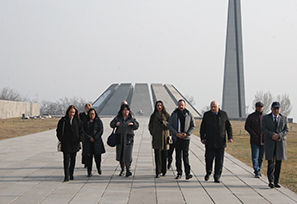
The chairman of the Armenia-Mexico friendship group of the Chamber of Deputies of Mexico visited the Armenian Genocide Memorial
17.01.2023
On January 17, the delegation headed by Berenice Juarez Navarrete, the president of the Armenia-Mexico friendship group of the Chamber of Deputies of Mexico, who arrived in Armenia on a working visit, visited the Armenian Genocide Memorial, accompanied by Gurgen Arsenyan, the head of the Armenian-Mexico friendship group of the National Assembly of the republic of Armenia, and Armella Shakaryan, the Armenian Ambassador Extraordinary and Plenipotentiary to the United Mexican States.
The guests were welcomed by Harutyun Marutyan, AGMI Director who narrated the history of the creation of the Memorial. He also presented them with the history of the three khachkars placed in the Tsitsernakaberd area in memory of the Armenians who died in the massacres in the cities of Sumgait, Kirovabad (Gandzak) and Baku in the last century organised by the Azerbaijani government. He also related the stories of the five freedom fighters buried in front of the Memory Wall (Hushapat) who were killed during the Artsakh war, emphasizing the connection between what happened and the Armenian Genocide.

The Speaker of the French National Assembly, Yael Braun-Pivet, visited the Armenian Genocide Memorial
13.01.2023
At the invitation of the Speaker of the National Assembly of the Republic of Armenia (NA RA), the delegation led by the Speaker of the National Assembly of the Republic of France Yael Broun-Pivet arrived in Armenia and visited the Armenian Genocide Memorial on 13 January, accompanied by the Speaker of the RA NA Alen Simonyan, RA NA Deputy Speaker Ruben Rubinyan, RA NA Armenia-France Friendship Group Head Vladimir Vardanyan, RA Extraordinary and Plenipotentiary in the Republic of France and accompanied by Ambassador Plenipotentiary Hasmik Tolmajyan and Ambassador Extraordinary and Plenipotentiary of France to the Republic of Armenia Anne Luyot.
The guests were welcomed by Harutyun Marutyan, AGMI Director who narrated the history of the creation of the Memorial. He also presented them with the history of the three khachkars placed in the Tsitsernakaberd area in memory of the Armenians who died in the massacres in the cities of Sumgait, Kirovabad (Gandzak) and Baku in the last century organised by the Azerbaijani government. He also related the stories of the five freedom fighters buried in front of the Memory Wall (Hushapat) who were killed during the Artsakh war, emphasizing the connection between what happened and the Armenian Genocide.
Dear visitor,
The Armenian Genocide Museum-Institute will be closed on January 6, 2023.
Sincerely,
The Armenian Genocide Museum-Institute Foundation
Dear visitor,
The Armenian Genocide Museum-Institute will be closed from December 31 till January 2, 2023.
Sincerely,
The Armenian Genocide Museum-Institute Foundation
| 




